




I had heard all the hype about Portugal, and was afraid that perhaps my expectations were a bit high. After all, I have explored many corners of the world and have fallen in love with heaps of amazing places. Since returning, I am unable to get this beautiful country out of my mind. I continue to listen to the Portuguese playlist on repeat (be sure to check it out later in the issue) and it takes me right back to the small dinner club where we soaked up an intimate evening of fado. I dream of the succulent meals we savored and the warm, engaging people we met. I remember the castles and gardens we explored and slept in, the painterly and fragrant landscapes we admired and the hand painted tiles that adorned countless buildings. The sights and sounds of Portugal seeped into every part of my being, awakening every sense, and I became utterly smitten. My expectations were exceeded in every way and I can hardly wait to return to experience more of enchanting Portugal.



At the far edge of Europe, on the edge of the Iberian Peninsula, and closer to Africa than to many other countries on the continent, sits the glorious country of Portugal. The coastal cities of Lisbon and Porto exude a vibrant culture that is rich in history (first occupied by the Phoenicians over 3,000 years ago!) and abundant in art. The Portuguese people, so warm and friendly, share a passion for food and flavors, music that sounds of heartbreak, and a general joie de vivre. The earthy landscape of this relatively small
country is widely varied, from the rolling vineyards of Europe’s oldest wine country (the Douro Valley) in the north down to the sun drenched beaches of the Algarve in the south. And from the cities and fishing villages along the west coast to the mountains and forests of pine, eucalyptus and cork trees in the interior. There is much to be explored, discovered and savored in this alluring country. The key is to go with a sense of curiosity and a desire to soak up all the delights of this seductive corner of the world.



Stepping onto a vintage yellow tram, I lurch up hilly lanes, dazzled, as I pass rows of buildings sheathed in the most exquisite hand painted azulejos (tiles) in a multitude of hues and patterns, laundry hung from their ironwork balconies and blowing in the breeze. From high on the hill I can see the Tagus River, and I imagine the countless people who have sailed its waters over the millenia, from the Romans to the Moors, and from famed explorers, including Vasco da Gama, to the tourists on modern day cruise ships. I step off the tram onto a busy street corner, dodging crazy drivers and chatting pedestrians. I head to a pastelaria (pastry shop), where I buy a pastel de nata (egg tart), just pulled from the oven. As I sink my teeth into its golden custard, the buttery crust shatters into tiny crumbs. It is pure heaven in a bite, and I can’t help myself from treating myself to another. As I walk up the street in a historic neighborhood, I hear the melody of fado drifting from a window and, although I don’t understand the words being sung, I can detect the feeling of melancholy in her voice. Further on, with the hot sun warm on my skin, I poke into a café for a cool drink, just as a waiter walks by with a plate of grilled sardines. These small gifts from the sea, emitting a pungent scent, are so loved by the Portuguese. This city, overflowing with charm and life, and arousing all of my senses, has captured my heart.









This gorgeous museum is housed in the former convent of Madre de Deus, founded in 1509. Hand painted tiles (azulejos) from the 15th century to the present are on display, including a panorama of pre-earthquake Lisbon 37 meters long, dating from 1730. The images on this panorama depict what Lisbon looked like before the Great Lisbon earthquake of 1755, which devastated the city. Tiles from Portugal, Turkey, Spain, India and


The Netherlands are on display, as well as stories about each country’s contribution to the evolution of this art form. It is quite fascinating to learn about the history of these beautiful works of art, which were initially introduced by the Moors in the 16th century. The preserved Manueline (Portuguese Gothic and Renaissance)
cloister and baroque chapel in the museum are exquisite to visit as well.
Rua Madre de Deus 4 Closed Mondays

Set in the lovely modernist Gulbenkian Garden, this museum showcases one of the most important private collections of international art spanning 5,000 years of history (including from Egypt, Babylonia, Armenia, Persia, Islamic Orient, Europe and Japan). The museum was built in the 1960’s specifically to showcase this collection of approximately 6,000 pieces amassed by the collector, Calouste Gulbenkian on his travels. Gulbenkian was of Armenian descent, born in Turkey. His family left Turkey to escape persecution of the Armenian community. He lived in Cairo, London, then eventually moved to Lisbon, where he lived the remainder of his life. Over the many years he assembled his collection, housing many pieces of his art in London’s British Museum and National Gallery, as well as in the National Gallery of Art in Washington. His dream was to have the entirety of his collection housed under one room. Several years after his death, his full collection was brought to Portugal and the museum carrying his name was opened. I particularly enjoyed the ancient marble sculptures, antique carpets and glass works by René Lalique.

Avenida de Berna, 45
Website: gulbenkian.pt
Closed Tuesdays

Saudade is a uniquely Portuguese word that can not be translated into another single word in any other language. It emanates a feeling of longing or yearning for someone or something one once enjoyed, but has lost… the deep melancholy of remembering and feeling the absence of that which will never again be (for example, the song of a fishwife to her husband, lost at sea).
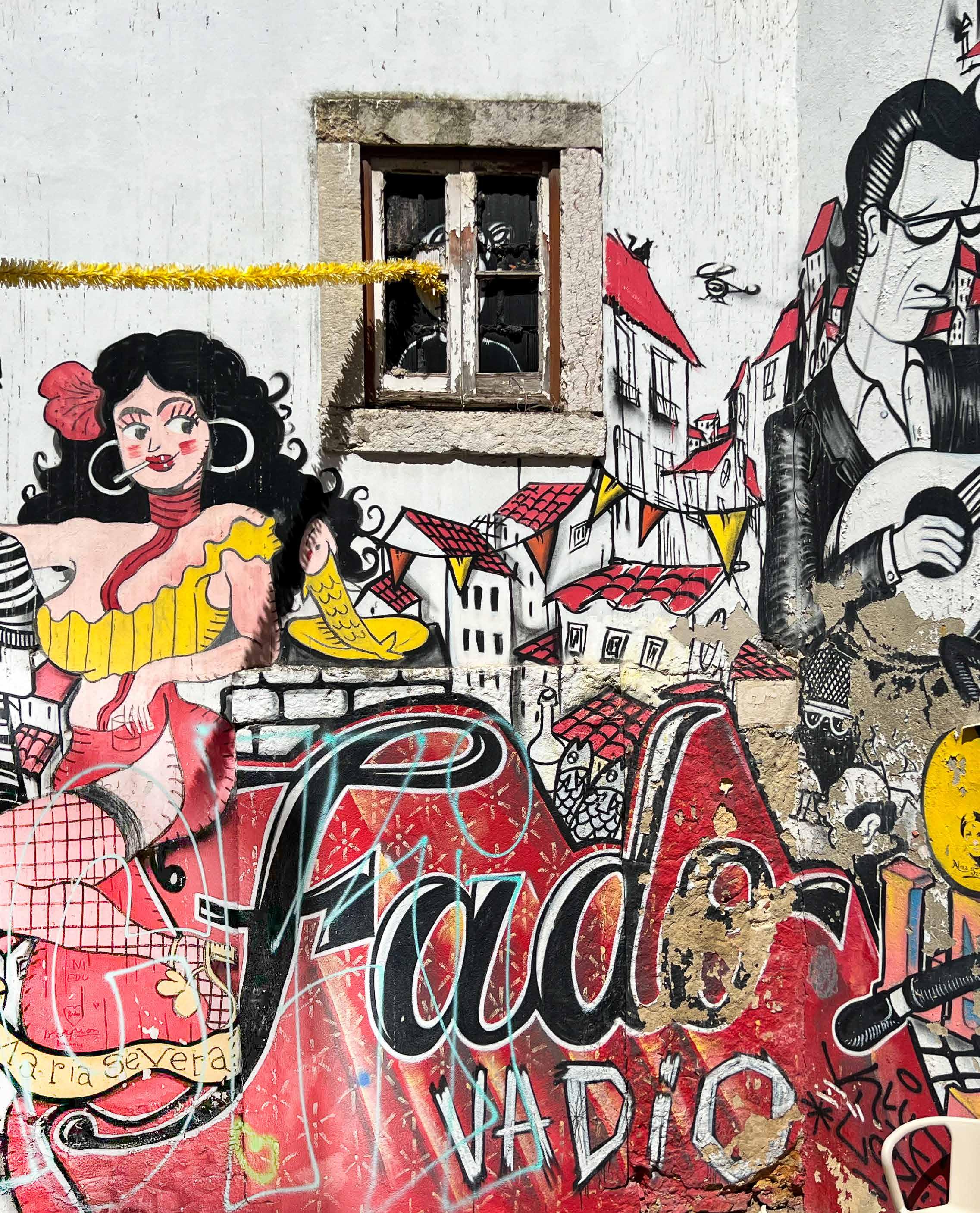
Fado, the style of song unique to Portugal, exudes the feeling of saudade. One can feel the sense of passion or sadness without the need for translating the lyrics. Fado originated in Lisbon the 1820’s, if not earlier, and a visit to Lisbon is not complete without attending a fado performance.


There are various places to experience a fado performance. I loved the small, intimate and homey venue we attended in Mouraria, the historical Lisbon neighborhood where fado was born. Amongst the orange trees, in a courtyard surrounded by apartments strung with clotheslines, sits a small and cozy house, filled with a handful of tables for guests. Dinner, consisting of warm bread, olives, cheese and beans, along with vegetable soup, sizzling Portuguese sausage and chicken in tangy mustard sauce with garlic rice, was served by candlelight during the performance. A man and a woman sang several songs both separately and together, as two guitarists strummed on Portuguese guitars. Their fingers moving on the strings as quick as lightning were as mesmerizing to watch as the deeply expressive faces of the vocalists, who were caught up in the emotion of saudade. The setting is authentic and traditional, more so than some larger venues catering to tourists.
Rua do Capelao, Largo da Severa, 2/2B Reserve via email or via your hotel.
In Lisbon there are electric tuk tuks galore zipping around the city. As we were waiting for a tram tour of Lisbon, a friendly man named João pulled up to us in his tuk tuk and asked if we were interested in a tour. We hemmed and hawed for a while, then chose to be spontaneous and agreed. When he spotted the large camera around my neck he was delighted to tell me he loves photography as well and would be pleased to take me around to the best photo photography spots around the city. We enjoyed our time so much that we extended our tour. The nice thing is we could do whatever we wanted, stop whenever we saw something of intrigue and take as much time as we liked. We took a break to enjoy gelato, visited some wonderful places of interest and ooohed and ahhed at several terrific miradouros (viewpoints). Now, where can I get a zippy electric tuk tuk to drive around my suburban American town? Because I think I need one.
Email: delicious.break@gmail.com
Delicious Break | João Lamas

This company offers a variety of groups as well as private tours both in Lisbon, Sintra and Porto, and the time is absolutely well spent. You will see parts of town you would not otherwise and it will undoubtedly enrich your travel experience.
We took the free walking tour of Alfama and Mouraria, the oldest districts in Lisbon. A free walking tour? Not quite. You pay what you want, but I have taken multiple free walking tours all over the world and always end up learning more in a few hours than I would on my own, so a tour is always worth at least the cost of a guide book, if not more.
Our guide, José, a transplant from Spain, is passionate about Lisbon and very effective in sharing his passion. We visited hidden neighborhoods and learned about the culture and tight-knit communities therein. One sweet old neighborhood we visited holds the community close and wants to remember each older person who passes away, so they make a plaque with that person’s photograph and a story about their life, and permanently attach it to a neighborhood wall. How endearing is that?
We learned the significance of St Anthony. June 13 is St Anthony Day, although sizable celebrations are held for a month, during which local neighborhoods go all out with decorations, barbecues and lots of noise. Every year a lottery is half for a small number of all-expenses paid weddings on June 13, which take place at St Anthony Cathedral and are televised throughout the country.
Website: hilisbonwalkingtours.com


This cozy and popular café serves brunch all day, featuring a seasonal menu of yummy breakfast dishes, coffee and fresh juices made from locally sourced ingredients.
Largo de Santo Antonio de Sé, 16 (Alfama neighborhood)

Calçada sao Francisco, 35 (Chiado neighborhood)
Website: dearbreakfast.com
José Avillez is a celebrated chef, the first Michelin-awarded chef in Portugal. He owns several restaurants in Lisbon (as well as throughout Portugal). His restaurant, Belcanto, has earned two Michelin stars and is currently listed as #42 on “The World’s 50 Best Restaurants” list.

Cantinho is Portuguese-inspired cuisine, with a twist, influenced by Avillez’s travels abroad. The menu is outstanding… everything is excellent. Be sure to save room for the chocolate cake with strawberry sorbet or vanilla and orange crème brûlée.

Rua dos Duques de Bragança, 7
Website: cantinhodoavillez.pt
Website: joseavillez.pt
Reservations essential
Image courtesy of Group Jose Avillez Image courtesy of Group Jose Avillez
“I’m Portuguese. I’m a chef. Here, I share what surrounds me, the things I experiment with, that which makes me think, and how proud I am of Portugal. This is my window from Lisbon looking out into the world.”
- José AvillezImage courtesy of Grupo Jose Avillez
For a succulent taste of Lisbon, eat a bifana… a tasty sandwich stuffed with a stack of thinly sliced pork steak, which has been slowly cooked on the stove in a bubbling sauce of white wine, garlic, butter and spices, and served with mustard. Make your way up the hillside to this teeny weeny café, where you will most likely need to eat your bifana standing up or on a bench in the adjacent square. As Bifanas do Afonso is the most classic place to order a bifana in Lisbon.

Rua da Madalena, 146
Cash only
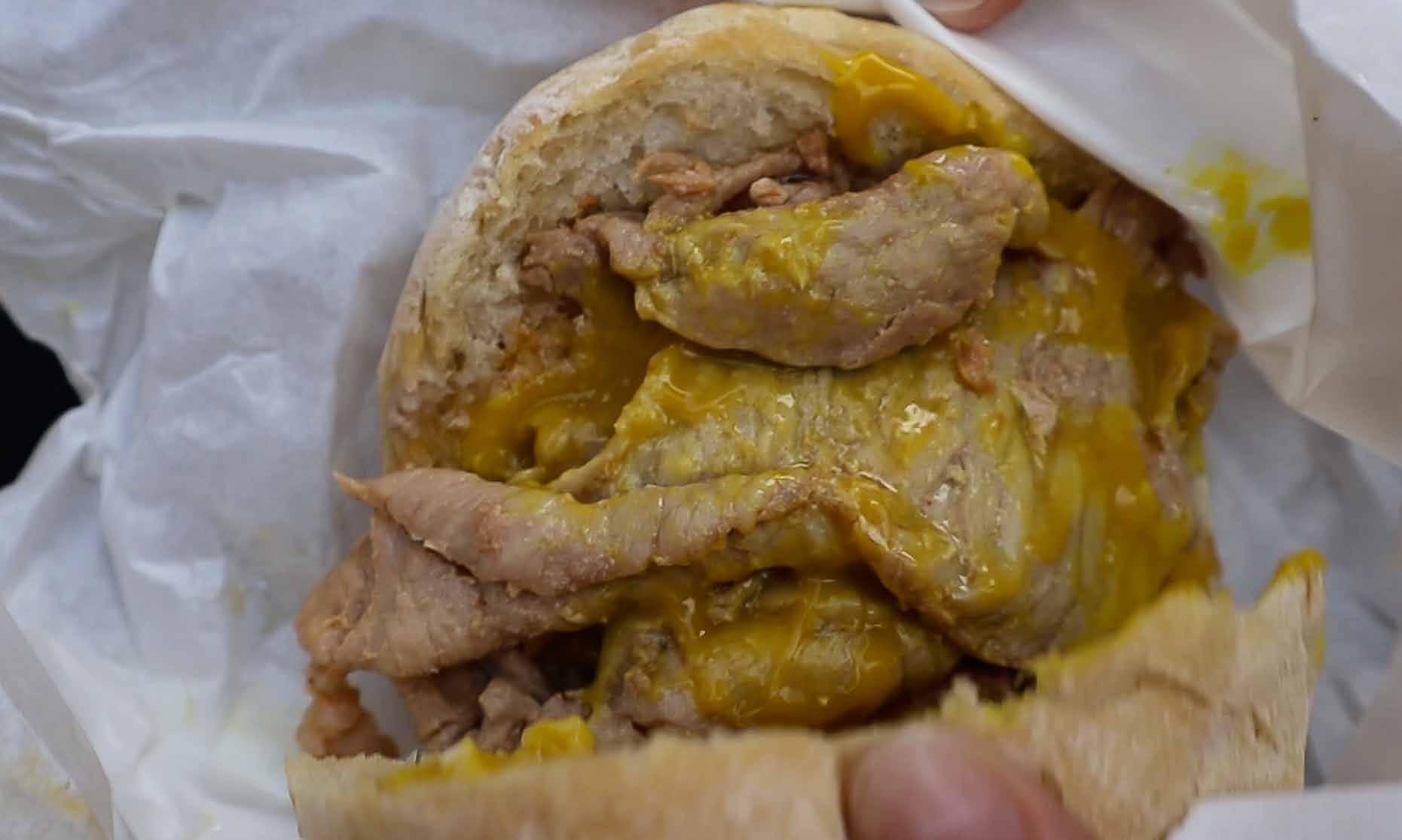

This authentic restaurant feels like a time capsule of what Lisbon might have been like 100 years ago. We met a British couple at the door, who had stopped by to make a reservation for a day or two later. They raved about the place and said they eat there every time they visit Portugal. We were lucky to get a table that evening, and dined on sea bass simply cooked in butter and garlic, with rice pudding (riz au lait) for dessert.

 Rua da Madalena, 117
Rua da Madalena, 117
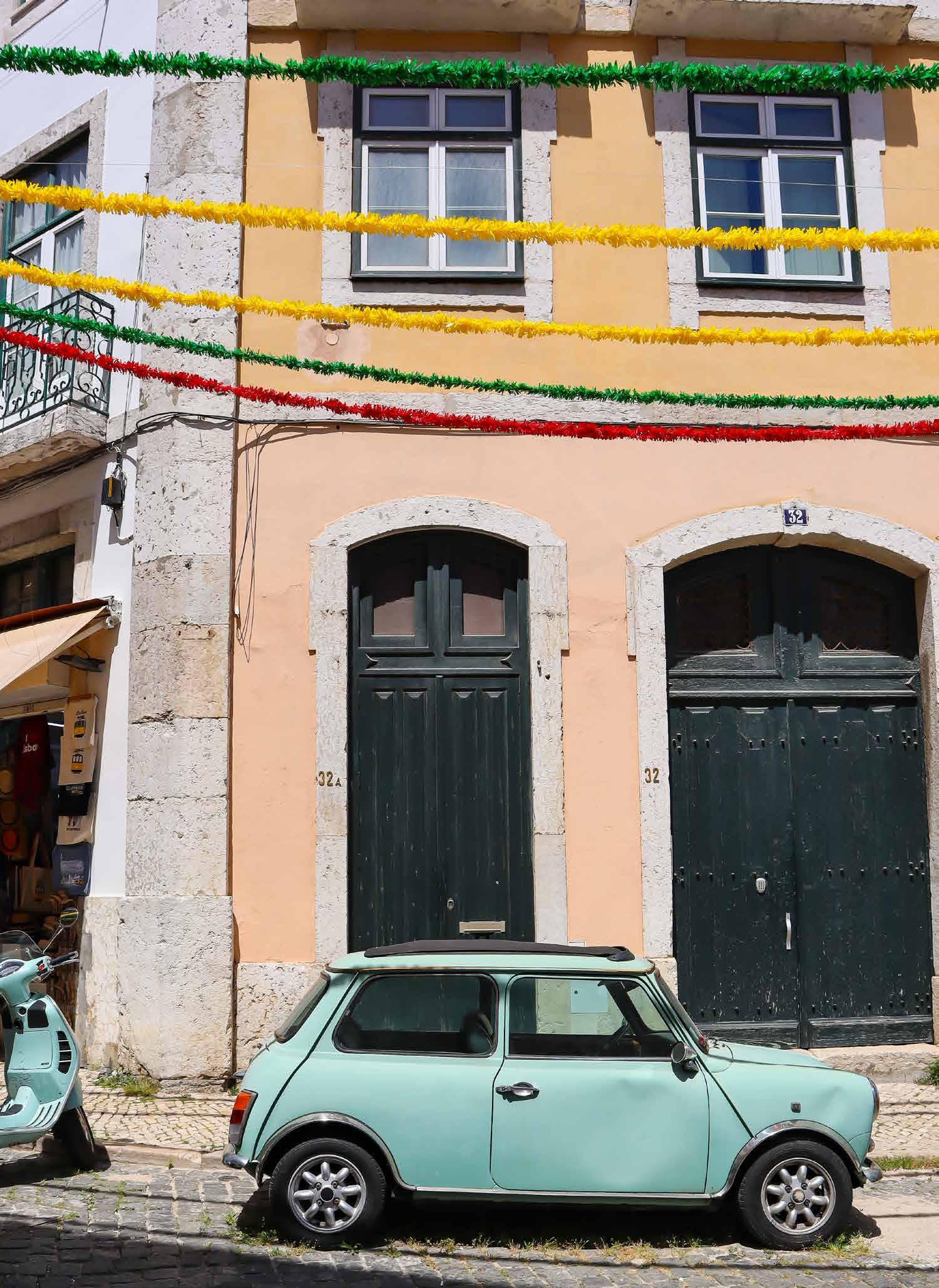




Hidden on a small side street, this little churrascaria (a place that sells Portuguese chicken piri-piri, found all over the country) specializes in chicken piri-piri, a much beloved dish in Portugal. The chicken is marinated in spicy sauce (containing garlic, piripiri chilies, lemon juice, olive oil and spices) and cooked on the grill, emitting intoxicating aromas. During the Age of Exploration in the 15th and 16th centuries, Portuguese explorers discovered many exotic spices in coastal Africa. They returned with piri-piri chilies, and the rest is history. We went to Frangasqueria Nacional for dinner and it was a one woman show; the poor lady was slaving away as the solo cook, dish washer and cashier. It was hot inside and the line was out the door. She was visibly exhausted, wiping sweat off her forehead with the back of her arm, and kept herself sane by singing and dancing along to the Portuguese jazz that played in the small space. She hustled between her tasks, basting the array of butterflied chickens on the grill, serving up said chicken with potato and rice accompaniments, clearing tables and manning the cash register. When the poor guy in front of us was handed his food, he asked for a plastic fork and she replied, clearly overwhelmed, “Go get one at a grocery store!” and he shuffled off, clearly wondering in which direction he might find a fork. With just a few small tables, which were already full, we clutched our order (with cutlery she graciously gave me, when I asked for them extra sweetly) and headed to a nearby park to eat our dinner. The chicken was DELICIOUS… so tender and spicy, and our garlic rice was out of this world. We hungrily devoured every morsel. This is a meal we recall often, with watering mouths, and we look forward to recreating this dish at home.
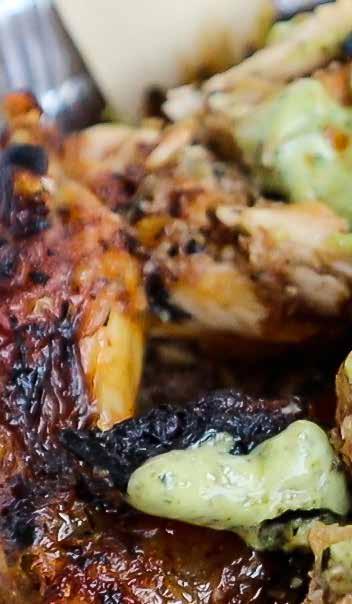 Travessa Monte do Carmos, 19
Travessa Monte do Carmos, 19


Pastel de Nata or pasteís de nata, if you’re referring to the plural (which is likely, since it’s impossible to eat just one) is one of the many culinary delights of Portugal. The melt-in-your-mouth Portuguese egg tart consists of a layered, buttery crust, which cradles a luscious egg custard center. They can be found at the many pastelarias (pastry shops) around the city. But the two most renowned pastelarias are listed below (and rightly so, as we tested pastel de nata in every single pastelaria we could find and concur that both are top dog).
The pastel de nata originated in the Jerónimos Monastery in the Santa Maria parish in Belém, Lisbon (worth a visit). At the time, convents and monasteries used countless egg whites for starching clothing. With all the leftover egg yolks they concocted cakes and pastries. Following the revolution of 1820, religious orders were dissolved and many convents and monasteries faced closure. The monks from the Jerónimos Monastery began selling pastéis de nata at a local sugar refinery to earn some income. The monastery closed in 1834 and the recipe was sold to the refinery, where it remained a secret.

In 1837, this historic pastelaria began making the original pastel de nata recipe created by the monks of Jerónimos Monastery, and the recipe is still kept a secret by this company. You can enter the shop in two ways: Through the door to the pastry displays, where you can order various pastries to take away, or through the entry to the old-fashioned café, where you can sit and enjoy lunch, pastries and coffee. You can also observe the creation of pasteís de nata through the large glass windows of the kitchen.

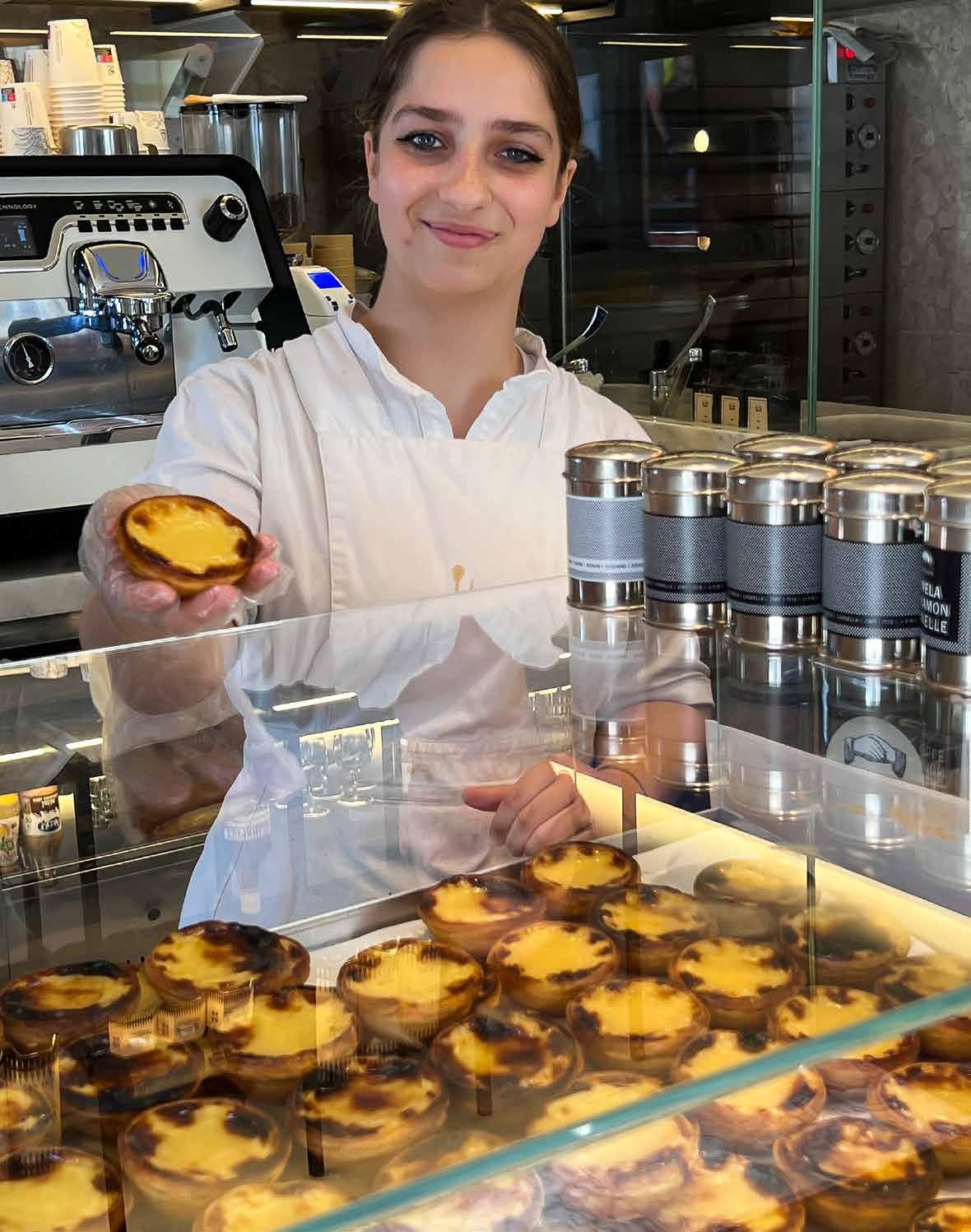
Rua de Belém, 84 Website: pasteisdebelem.pt
Many people play the “Which is Better?” game, so we played right along. We stepped inside of Lisbon’s three branches of Manteigaria, where pastéis de nata had just been pulled, piping hot, from the oven. Let’s just say we were convulsing with ecstasy with each bite. We had ourselves a clear winner… We think these are THE BEST pastéis de nata! Oink.
The morning we regretfully drove out of Lisbon in a just-rented car, we went out of our way to find Manteigaria to take away one last box of these delectable tarts.
Rua do Loreto, 2 (one of three branches in Lisbon, as well as two in Porto!)
We tried various gelato shops in Lisbon (at least one or two every day) and this is our favorite, with unique flavors such as vanilla with basil, lemon with rosemary and honey, fig with nuts and port wine, Madeira passion fruit, and more flavors that will thrill your tastebuds.
 Rue da Madalena, 83 Cash Only
Rue da Madalena, 83 Cash Only




This 19th century building, sitting pombaline ruin Lisbon, was converted 15 comfortable apartments, fusing and modern aesthetic. called The Lisboans idea being to make like locals. Each of locally procured items is left outside door, so you can leisure, without set breakfast times. this service! The efforts to be sustainable use resources conscientiously, as well as giving community in any Located conveniently you will find Prado where you can provisions, as well restaurant, Prado guide they provide contains oodles recommendations sights, shops and The location is and we loved the neighborhood.
Travessa do Almada, Website: thelisboans.com
 Image courtesy of The Lisboans
Image courtesy of The Lisboans

century factory sitting upon Roman ruin in historic converted to house and charming fusing a traditional aesthetic. It was Lisboans with the make guests feel Each morning, a bag procured breakfast outside your can dine at your without the confines of times. We loved The owners make sustainable and conscientiously, giving back to the any way they can. conveniently next door, Prado Mercearia, shop for picnic well as the sister Prado. The city provide each guest oodles of fantastic recommendations for nearby and restaurants. fantastic, the charming Almada, 9 thelisboans.com

 Image courtesy of The Lisboans
Image courtesy of The Lisboans
Image courtesy of The Lisboans
Image courtesy of The Lisboans

This award-winning hotel, occupying the 15th century Pálacio dos Castros is tucked on a quiet, leafy haphazard manner, the interior is like a labyrinth, without any right-angled walls in the building. well-appointed, spacious and comfortable. It is a peaceful place to return after a busy day of sightseeing. café, which emanates a lovely, relaxed vibe.
Rue de Santiago 10-14
Website: santiagodealfama.com
Image courtesy of Santiago de Alfamaleafy side street in Alfama. Constructed in a building. The location is convenient and the rooms are sightseeing. Enjoy a meal at the hotel’s outdoor

Silent Living is the brand of João Rodrigues and his family, who welcome guests as friends into their six family homes in Portugal.


The concept is this:
Each house has been one of their family homes and holds the memory of their family’s happiness, as they have gathered with friends, family and travelers in each home. Silent Living embraces a lifestyle of happiness and fulfillment.
The aim of their Lisbon peaceful ambience of homemade bread.
The essential ingredients building, being local, house, the materials
Salt Lake City stylist, described their visit
“The minute we walked was meticulously converted Alfama neighborhood, with the river beyond. which created a palpable effortless. Every day we looked in the dining room.
Campo de Santa Clara, 128 Website: silentliving.ptLisbon house, Santa Clara 1728, is to ensure each guest feels embraced by the quiet and ambience the house exudes, through its use of light colors, the smoothness of materials, even the scent bread. Portuguese culture is imprinted on the guests in a very soft and subtle manner.
ingredients imbued in each Silent Living project include: A sense of home, the memory of the local, the simplicity of the architecture, the sense of family, the way nature embraces each materials used and the atmosphere felt in each house.

stylist, Cammy Fuller, recently returned with her husband from a stay at Santa Clara 1728. She visit as follows:
walked into Santa Clara 1728 we knew it was going to be special. This beautiful old home converted into a refuge from the bustling city of Lisbon. Set on a quiet street in the historic neighborhood, every room has a spectacular view of the Church and Convent of São Vicente de Fora, beyond. The interior was so thoughtfully designed in the most simplistic, yet sophisticated way, palpable sense of peace. This striking contrast to the city outside was intentional, yet felt
looked forward to breakfast and the late afternoon tea cake and snacks that were waiting for us room. I truly wanted to stay there and never leave.”
Image courtesy of Santa Clara 1728A charming collection of over 400 products from Portuguese artisans and companies all under one roof, this shop is the ideal place to pick up gifts for friends or family back home.

Rua Anchieta, 11
Website: avidaportuguesa.com
What a beautiful tea shop in what was once an old shoe store from 1880. There is a plentiful tea selection from around the world, including special blends. This fragrant tea is served in the best restaurants, hotels and cafés in Lisbon.
Rua do Poço dos Negros, 105
Website: companhiaportuguezadocha.com

 Images courtesy of Companhia Portugueza do Chá
Images courtesy of Companhia Portugueza do Chá
One of Portugal’s most beloved skincare brands, founded in 1925 by a Lisbon-based pharmacist, who created handmade beauty potions and packaged them in a pretty palette of classic art deco tubes. Portuguese women love these beauty products today as much as they did nearly a

hundred years ago. The rose scent, pictured, is a tribute to Queen Amélie who was one of Benamôr’s first fans in 1935
Rua dos Bacalhoeiros, 20A (as well as four other locations in Lisbon & one in Porto)
Website: benamor1925.com
Image courtesy of Benamôr 1925
















Like a verdant garden of Eden spilling down the hillside, Sintra is a visual delight, dotted with historic palaces, castles and villas.

Crowning the hilltop sits the spectacular Pena Palace (Palácio Nacional de Pena), a storybook castle, replete with detailed stone carvings and watchtowers, and painted a rich yellow. The castle was built in the European Romanticist style in1838 by King Ferdinand on the remains of a 15th century monastery. It served as a summer residence for the Portuguese royal family until the last queen, Amélia, was driven into exile, due to the revolution in 1910. Much of the interior remains untouched, as it was up until the royals were driven out. The castle is a UNESCO World Heritage Site and a delight to explore. Tickets are sold for specific time slots.
Website: parquesdesintra.pt

From the palace, we crossed the street and walked along a trail down to the Moorish Castle. The fortifications date from the 10th century when the Moors occupied the Iberian Peninsula. From along the parapet walk, one sees magnificent views of Sintra, including Pena Palace, attractive villas studding the hillside, pine forests and the azure blue Atlantic Ocean below.
Website: parquesdesintra.pt

After walking along the castle walls, we descended by footpath until we arrived at a lovely restaurant overlooking the National Palace (once home to Prince Henry the Navigator). Dona Maria is a nice spot for lunch or a drink on the terrace, where you have a bit of time to relax and rest tired feet.
Beside Dona Maria is a charming little antique shop, Oh Gente da Minha Terra, brimming with a beautifully curated collection of antique tiles, pottery, art and so much more. It was a treasure trove and I could have dropped quite a few Euros there but, with limited luggage space in mind and exercising oodles of self restraint, I left with a sweet little hand painted blue and white tile from the late 17th or early 18th century.
Largo Ferreira de Castro, 3
Website: dona-maria.pt
Largo Ferreira de Castro, 3


We continued further along the road until we arrived at Quinta da Regaleira, a neo-Gothic mansion set amongst absolutely enthralling gardens, which contain a not-to-be-missed Knights of Templar initiation well, secret passages, chapel and a small Rapunzel-style tower. We walked through the mansion, but the gardens were definitely the most enchanting feature of the property, which was built by an eccentric aristocrat. Website: parquesdesintra.pt

Tip: People often ride the train from Lisbon to Sintra, but we found it very convenient to get there via Uber, and had the driver take us directly up the steep hill to the ticket machines just below the Palácio Nacional de Pena. It certainly saved us quite a bit of time. At the end of the day, with very tired legs, we opted to return to our hotel in Lisbon via Uber as well, although I wished we had spent the night in Sintra, as there is more to see and experience in this relaxed and sublime town.
Website: regaleira.pt
Portugal’s breathtaking southern coast is strung with nature reserves and orange groves, touristic towns and days soaking up the sun on a dazzling beach and kayaking hinterland, or meandering along cobbled lanes in whitewashed enticing
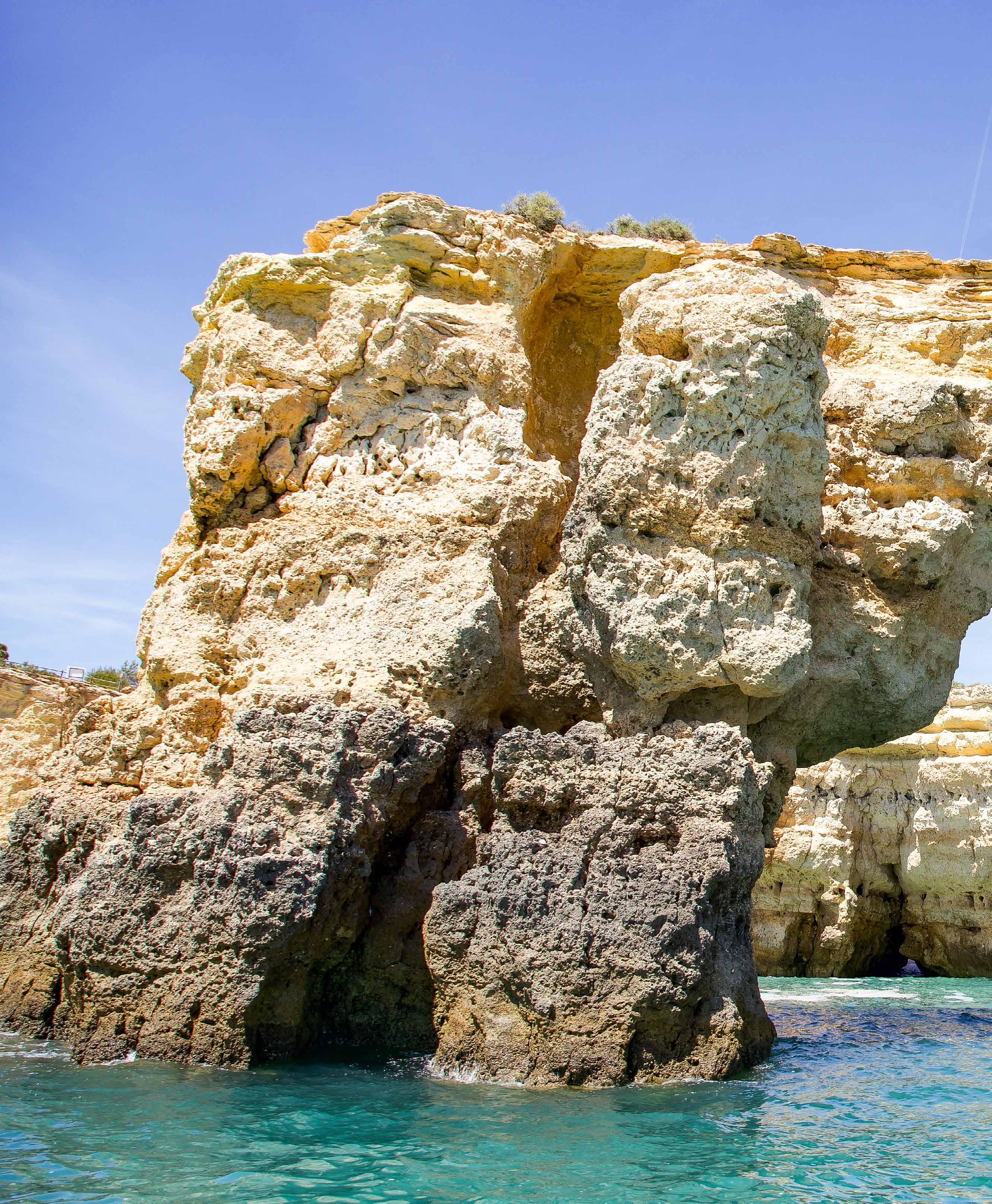
with golden sandy beaches and coves, caves and cliffs, and tiny hill villages. Whether you want to spend your kayaking in the sea, hiking along coastal trails or in the whitewashed villages, there is much to explore in this enticing region.



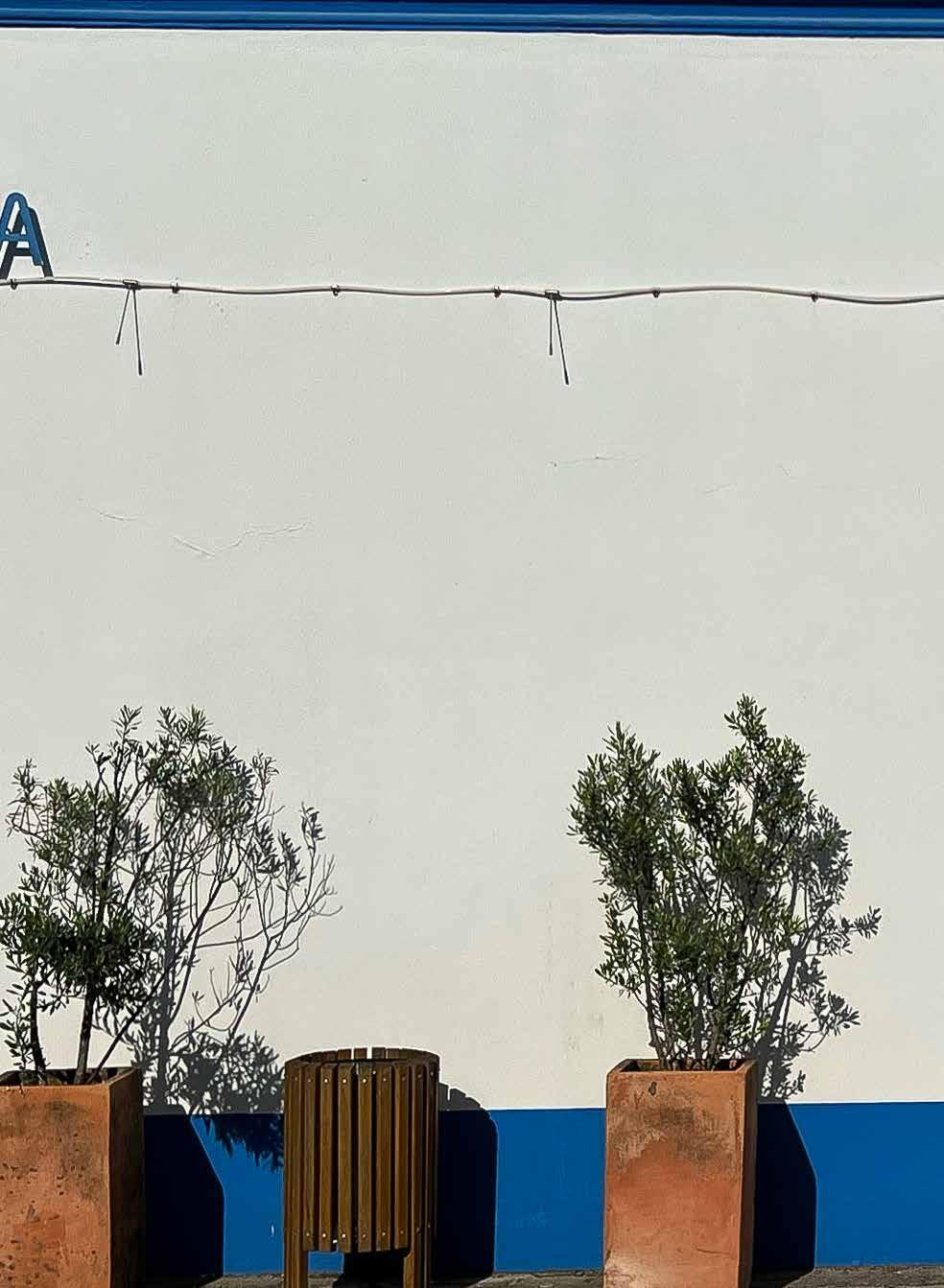




An absolute highlight is to view the beautiful coastline by boat, to see the Algarve from a different perspective. You will pass along stunning scenery, rock formations, caves and private beaches. Lined up in a row at the marina in Albufeira there are several tour companies offering a variety of scenic cruises on all types of boats. You can browse options and available times, or book online.

AlgarExperience is just one of several tour companies (tried and true!). It offers a fun variety of tours and your cruise will be a memorable one. The 2.5 hour Benagil Caves & Dolphins tour in a rib boat (speed boat) is a thrilling way to experience the rocky shoreline as well as heading out to sea to view the pods of dolphins that swim right alongside the boat.
Website: algarexperience.com
If you have the time you can hike the 12 kilometer Seven Hanging Valleys trail, passing magnificent coastal scenery, between Praia da Marinha in the east to Praia do Vale de Centeanes in the west.
Website: walkalgarve.com


Sitting on a beautiful beach, Praia do Vale do Olival, this breezy, open restaurant is a fusion of Portuguese and Asian cuisine. The owner, Tomás Rodrigues, is a mellow fellow who loves to travel the world and bring ideas back into his kitchen. The menu is delicious and interesting; for example, the grilled salmon with aromatic mashed potatoes and hot passionfruit sauce… an explosion of flavor. Finish your meal with a walk on the pretty beach among the cliffs and rock formations.
Praia do Vale do Olival, Porches (west of Albufeira)



Tucked in the eastern Algarve, close to the border of Spain and not far from Tavira is a picturesque, whitewashed village with a labyrinth of cobbled lanes seated Moorish influence (from 500 years of Moorish occupation!). Tiny hill villages hinterland, a natural park, hiking trails and beautiful beaches strung along the this an intriguing area to visit. The seafood is fresh and abundant here.

Africa, historic and a deepvillages tucked in the the coastline make


There is an unusual anchor graveyard that memorializes a lost fishing technique called Almadraba, which was likely invented by the Phoenecians more than 3,000 years ago. The technique involved numerous wooden frames covered with nets, held in place in the sea with hundreds of anchors, directly in the path of migrating tuna. This manner of fishing was practiced until the 1960’s by approximately 80 families of fishermen, who built a small railway to transport the fish… until the tuna changed their migratory path. Consequently, the fishermen had to find a different livelihood, abandoning their cottages and anchors. It is certainly an unusual place to visit.
Access to the island is via a small red train or by footbridge and a walking trail.

A favorite local restaurant just across the street from the sea offering Mediterranean and Portuguese cuisine. The seafood is delicious, as is the steak
Rua da Fortaleza, Edifício Cabanas-Mar, Loja 6, Tavira


Be sure to reserve a table outside to enjoy the buzz of this lively street in historic Tavira. You can’t go wrong with the fresh seafood and a big, fresh salad.
Rua Doutour José Pires Padinha, 142

The local supermarket has a juicer where you can juice fresh oranges into plastic bottles for a song. This is the most delicious orange juice I have ever imbibed… we went to get our fill every morning from the juiciest Portuguese oranges!.


For an enchanting local experience, stay in a restored old country house in the hills about 15 minutes drive inland from Tavira, in a tiny village among the foothills of the Serra Algarvia. Hike along surrounding trails or enjoy the scenic drive past vineyards and orange groves to the area’s beautiful beaches.

There are four charming holiday homes to choose from, each one thoughtfully designed and ideal for self-catering. Lina and Helge, the Lisbon-based hosts, are extremely responsive and helpful. They are currently working on a new restoration project in the beautiful village of Estremoz, in the Alentejo region.
Website: casas-da-serra.pt

This little gift shop carries a nice variety of Portuguese products (cork, ceramics, bath and body, food, and much more). I love the focus on local products throughout this incredible country.
Rua António Cabreira, 15

A beautiful region in Portugal’s interior, stretching Alentejo is known for its hot, dry plains, rolling hills, eucalyptus forests. The cuisine of the region is seriously are highly acclaimed. Formerly occupied by Moors, influences in the Alentejo run deep, with ruins dotting villages and medieval

stretching from the coast to the Spanish border, the hills, historic fortified towns, cork trees, pine and seriously delicious and the wines from local vineyards Moors, Romans and Carthaginians, the cultural dotting the landscape, along with sleepy whitewashed medieval dwellings.

The capital of the Alentejo and so deeply steeped in rich history, Évora is a medieval town with historical walls, a 13th century cathedral, palaces and the ruins of a Roman temple dating from the 1st century. It is a living museum, with much to explore.
 Image courtesy of Do Largo
Image courtesy of Do Largo
While visiting the gems in this UNESCO World Heritage Site (including ancient Roman ruins and the incredibly unique Chapel of Bones), enjoy a lovely outdoor breakfast or lunch at Do Largo, a bakery, café and market where you can dine on fresh, healthy food while giving your feet a rest and people-watching in the pretty, leafy square.

Largo de Álvaro Velho, 5 & 6 Website: merceariadolargo.pt
 Image courtesy of Do Largo
Image courtesy of Do Largo
Pop into this artful shop, next to Do Largo, where you will find an irresistible collection of colorful, hand painted pottery, local food products and other artisan creations.
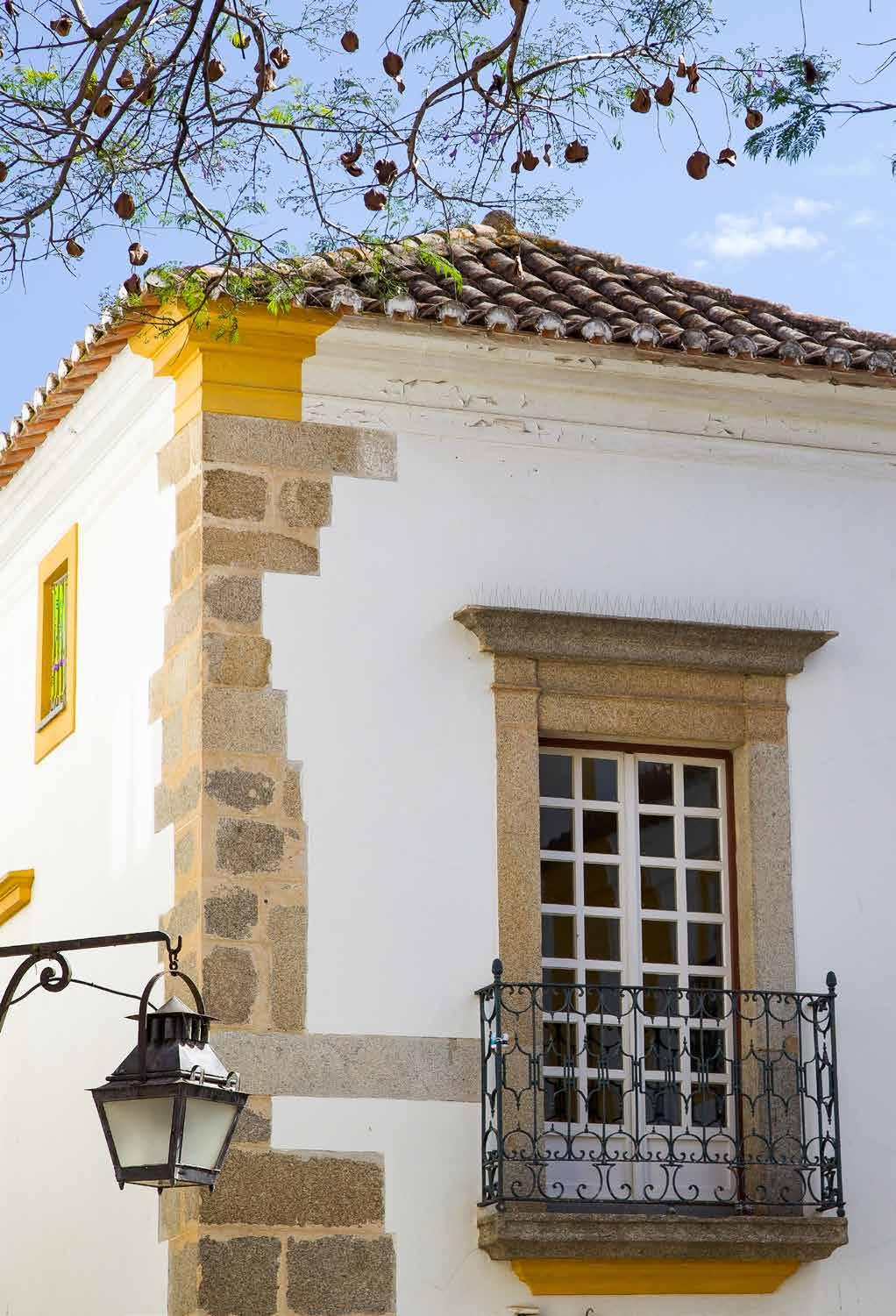
Largo de Álvaro Velho, 7A


This low key luxury hotel is in the countryside 9 miles from the bustling town of Évora. The design is modern organic with a focus on locally sourced materials and artisan work. We loved this peaceful hotel and appreciated the thoughtful amenities (including sun hats and straw bags in each room and villa), an extensive breakfast spread, beautiful indoor and outdoor pools, spa, gym and bicycles for guests to borrow. The garden supplies the delicious meals served in the restaurant. Steeped in nature on 11 hectares, it is a relaxing place to enjoy the gorgeous Alentejo region. A little menagerie of farm animals on the property are sure to please the little ones.

Herdade do Perdiganito, It 52 Our Lady of Machede
Website: evora.octanthotels.com
 Images courtesy of Octant Hotel Évora
Images courtesy of Octant Hotel Évora

Estremoz is known as the white city of Alentejo, as all the houses are whitewashed, which helps them retain coolness in the summer heat. The historical center is quite beautiful. The renowned Estremoz marble, exported around the world, is extracted from the surrounding quarries. Many of the buildings and even the sidewalks throughout town were built of the local marble. The food scene here offers a creative and modern twist on traditional Alentejo cuisine, while surrounding vineyards provide much of the wine celebrated by locals and travelers.




The fertile soil of the Alentejo region produces the abundance of ingredients for revered wines and other fine foods, which are featured in this exceptional Michelin-star restaurant, wine cellar and gourmet market. We enjoyed a magnificent dinner of black pork cheeks, goat cheese gratin with pear, honey and walnuts, topped with thyme ice cream. We were licking our chops all the back up the hill to our hotel.
Largo Dragõs de Olivença, 84A Website: merceariagadanha.pt
Images courtesy of Restaurante Mercearia Gadanha

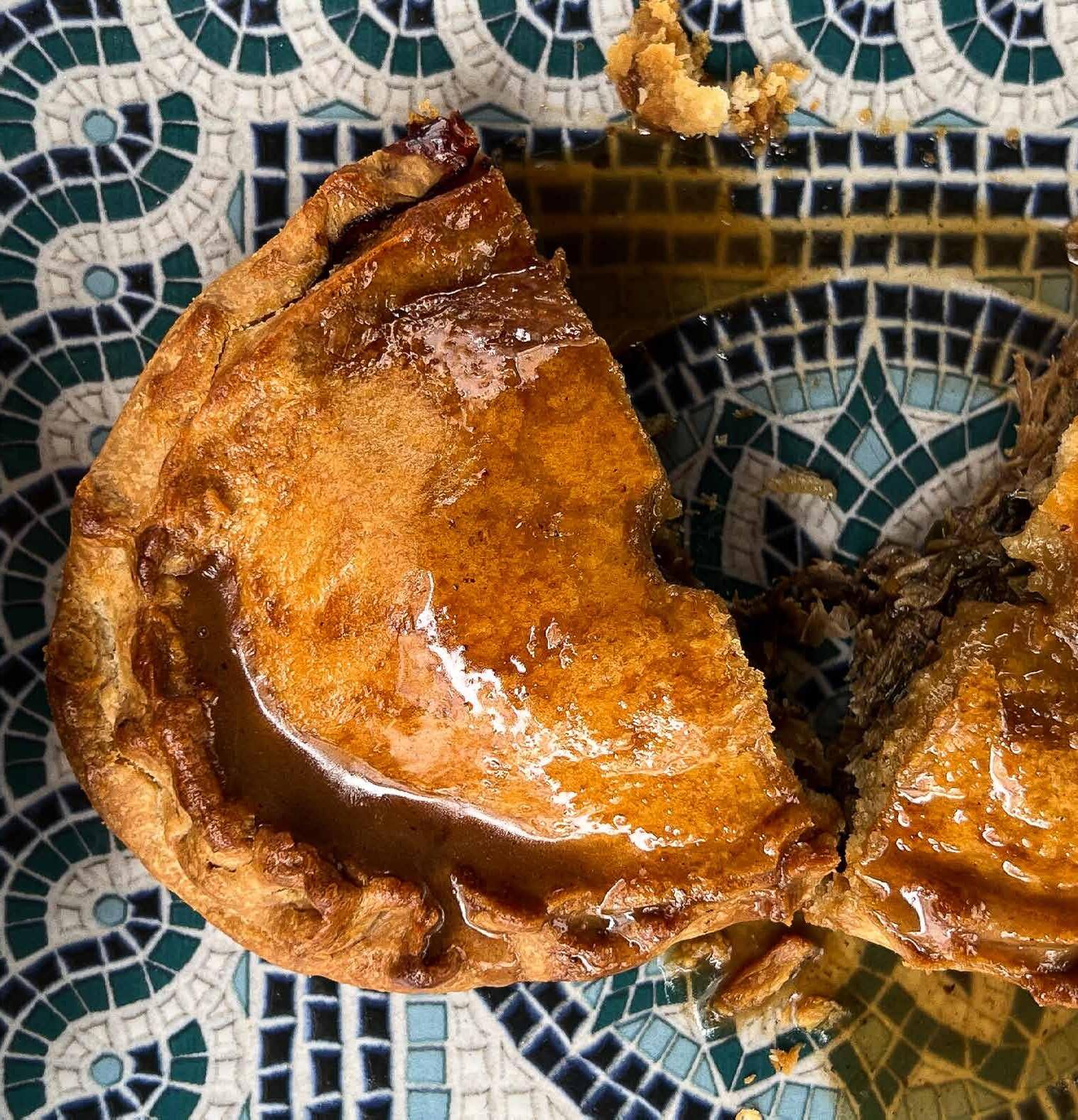
We enjoyed the most delightful lunch here. Paulo, our personality-plus server, was keen to share all the menu details and advise us on what to order. We ate a scrumptious lunch of fava bean tempura with aioli and a Portuguese empada (or empadinhas), which is similar to a meat pie and dates back to medieval days. The dessert was sublime… rice pudding flambé topped with cinnamon ice cream! We had such a nice time chatting with Paulo and learning more from him about Portuguese cuisine. At the end of our meal, he graciously gifted us with a bottle of locally produced olive oil!
Largo General Graça, 52
Just a 30 minute drive from Évora, and a bit less congested, Estremoz makes a good base for a day trip to Évora’s historical sites.
This sweet boutique hotel was created by the woman who owns the Restaurante Mercearia Gadanha, just down the street. Housed in a renovated old manor house and with just 12 rooms, this is a charming and centrally located place to stay while enjoying this lovely town.
https://casadogadanha.pt/home/?lang=en
Like the paradors in Spain, pousadas are exclusive hotels in historic buildings across Portugal. Topping the hill in Estremoz and surrounded by historical walls, this splendid castle was built by King Dinis for Queen Santa Isabel in the 14th century. Stay in one of the comfortable 33 rooms, some with nice views of the city. It’s an easy walk down the hill into town.
Website: pousadasofportugal.com
Click here to see more of Portugal’s 34 pousadas.

A short walk from the castle, this antique shop is a treasure trove, full of interesting ceramics, folk art and many other collectibles. Being one who loves learning about the history of antiques in places I visit (because I subsequently learn more about the culture), I enquired about some hand painted pottery that caught my eye. I was told it is called Faiençe Ratinho, named after the men who came to Coimbra in the 17th and 18th centuries to work in the surrounding fields, trading their beautiful pottery for clothes and other necessities.
Rua Calçada da Frandina, 23If you are in town on a Saturday, head into town to the largest antique market in the Alentejo, held weekly. Here you will find all sorts of old things, including art, books and ceramics, as well as plants, produce and artisan food from the region.
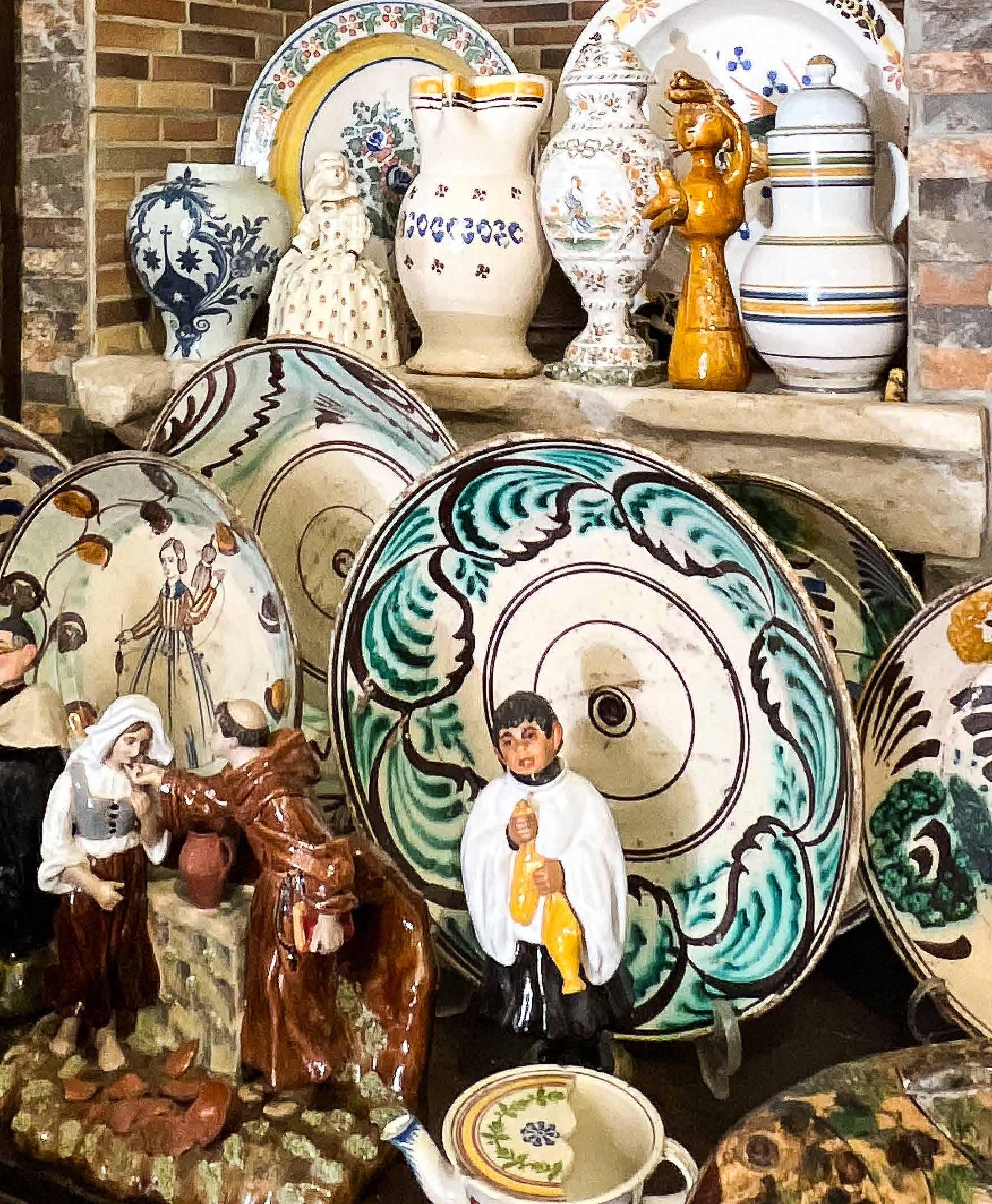
Oh my, what a perfectly picturesque village! The quaint Óbidos fill up with day-trippers, so it is a town best explored the top of the fortified wall that encloses this medieval tiled rooftops to the surrounding


quaint
cobbled lanes in the maze of whitewashed houses of explored in the morning or evening. Be sure to walk along medieval village, where you will see splendid views across the surrounding countryside.


This magnificent castle, with medieval features from the 9th century, was a wedding gift by King Dinis to Queen Santa Isabel. It is considered to be one of the 7 wonders of Portugal. Located at the village wall, with 17 rooms, is the perfect location to stay when visiting Óbidos.
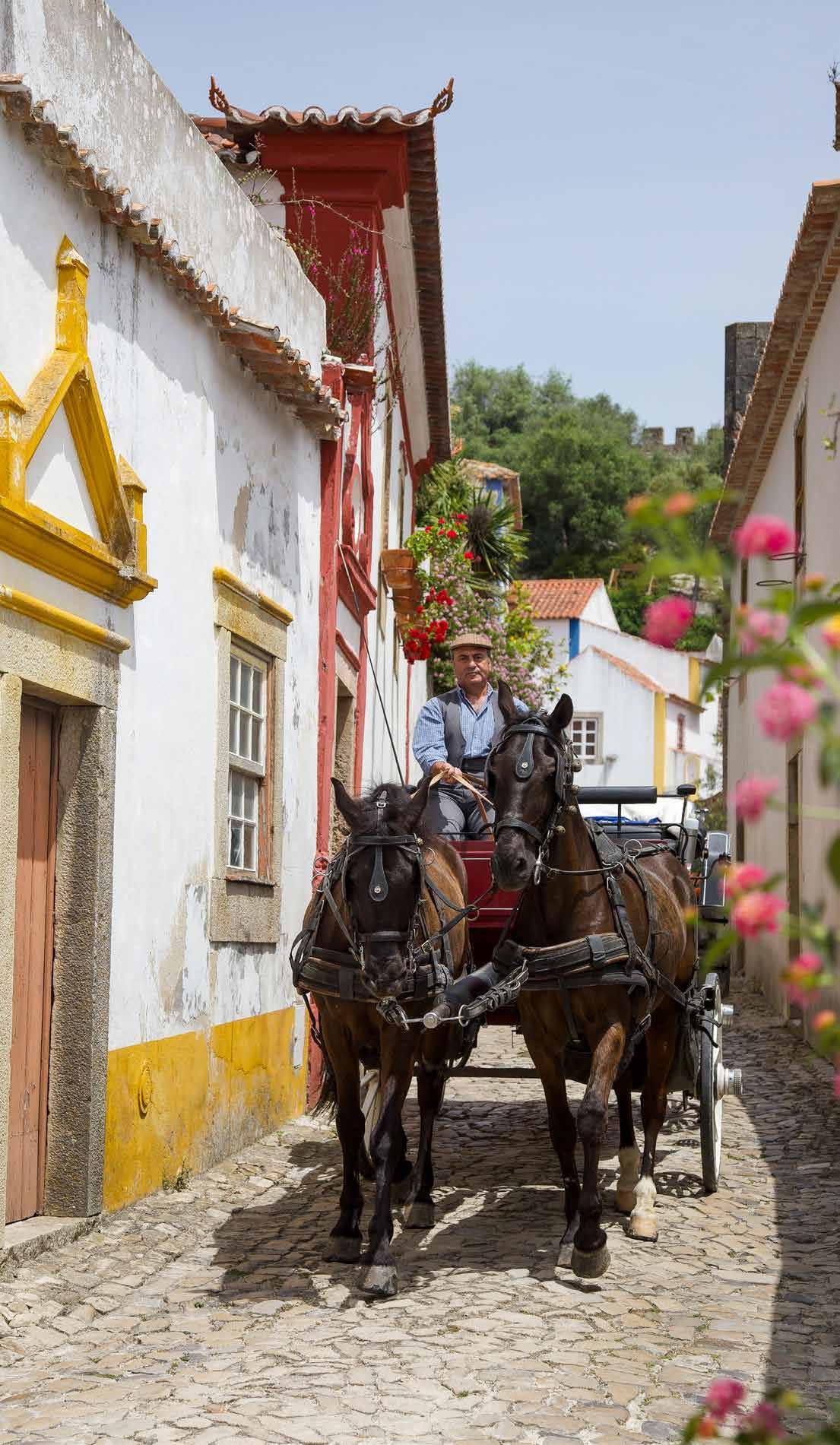
This is a sweet shop selling women’s clothing, accessories and home decor, as well as food items. The owner can make you a charcuterie board to enjoy outside on the terrace or tableside in the charming lane.
 Travessa Gomes Figueira, 2510-001
Travessa Gomes Figueira, 2510-001
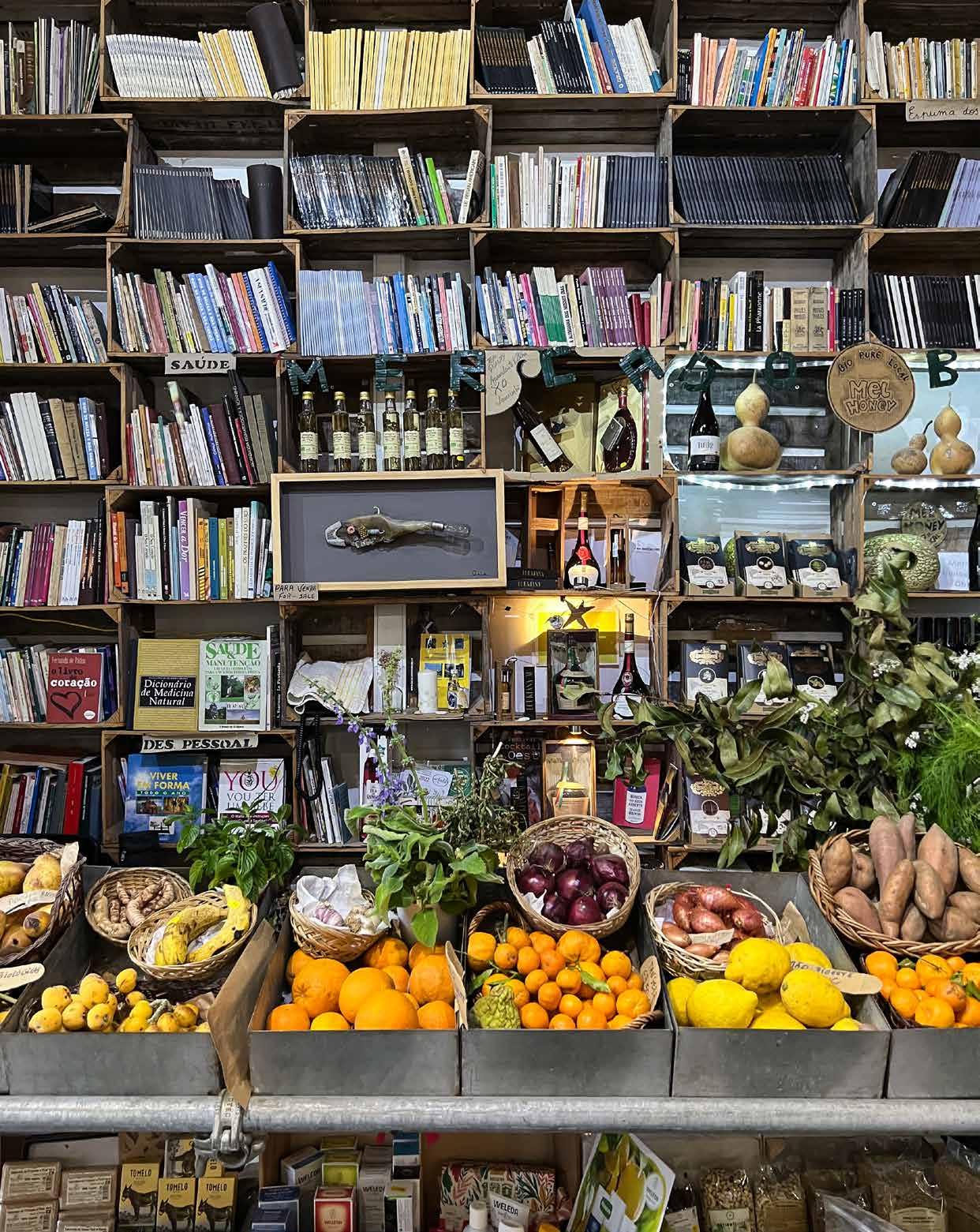
Books meet organic produce… An unexpected combination, this shop is a cacophony of books, which are displayed in a huge number of crates nailed to the walls. While perusing various titles, you can stock up on lettuce or carrots. I left with a packet of seeds for some sort of leafy green, which the proprietor amusingly explained (by acting out charades, making the whirring sound of a blender and throwing her head back while pretending to drink and saying “Mmm…) was excellent in smoothies. So we will see how that goes.
This small shop is run by the local government, and the focus is on the ceramics known as verguinha, a handicraft of Italian origin that was somewhat of a lost art, until it was brought to Portugal by the renowned Portuguese artist, Bordallo Pinheiro. It has since become an iconic creation unique to this region. The clay is woven in the style of local wickerwork baskets, used for the grape harvest and the carrying of fruits that grow in the surrounding area. The pieces are made on site by two skilled artisans, and the workmanship is finely detailed and delicate.
 Rua Direita, 95
Rua Direita 27
Rua Direita, 95
Rua Direita 27
We arrived in Coimbra during graduation weekend. Graduates from the University over town, wearing their distinguished black robes and capes, along with colorful ribbons specifically wanted to visit this beautiful university and its exquisite Joanine Library, two colonies of bats (which were sleeping during our visit, hidden in the tops of bookshelves insects from damaging the historical volumes, of which there are approximately 56,000, moths at bay means cleaners must enter the library each
Students from 115 countries attend this research university, which is also known as world listed as a World Heritage Site. There is a deep sense of history in the air on your

University of Coimbra (one of Europe’s oldest universities, founded in 1290!) were seen all ribbons associated with their specific colleges. The entire city was in celebration. We Library, available for touring via timed tickets. We learned that the library is home to bookshelves near the very high ceiling). At night they hunt for moths, which keeps the 56,000, dating mostly from the 16th to 18th centuries. This clever method of keeping the morning to pick up after the events from the night before.
the most sustainable institution in Portugal. It is only one of five universities in the campus and throughout town. Be sure to visit the colorful chapel, if it is open during your visit.


Up a little side alley sits a tiny, authentic hole-inthe-wall with merely a few tables. We waited just over one hour to get a table, and we certainly were glad we did as soon as we put the first bite into our hungry mouths. This ranked as one of our favorite meals in all of Portugal, and many others agree, judging from the countless notes from happy guests which cover the walls (including the food buyer for Trader Joe’s). Portions are massive. Google Translate comes in handy here, and they accept cash only.

Beco do Forno, 12

Positioned on a hilltop, right next to the university, we really enjoyed this small, charming hotel. It has a restaurant and a rooftop terrace. Each room is named after a writer connected to the city, its university and to the famed literary meetings of Coimbra.

Website: sapientiahotel.com



In the north of Portugal, straddling the Douro River, lies the picturesque and vibrant city of Porto, slightly smaller than Lisbon, its neighbor to the south. The city’s historic center, designated as a UNESCO World Heritage Site, is criss-crossed with charming lanes, beautiful churches and one of the most gorgeous train stations in the world.


Porto boasts a plethora of fantastic restaurants and a wine-loving population (port comes from Porto), with many wineries from the nearby Douro Valley keeping the city satiated at countless wine bars and restaurants across the river and throughout town. With its rich history and culture, it is a marvelous city to visit and explore.





If you do one thing in Porto, make sure it is this! We joined the Vintage Food Tour and it was the highlight of our visit to Porto! Our guide, Miguel, was such fun to spend half a day with, and we so enjoyed all of the unique foodie spots we visited and the many interesting facts and stories he shared about his beloved city. Everything we tried was new for us and much of it unique to Porto, including the variety of unusual pastries, each with a story. Miguel knows the purveyors and the history behind every shop, restaurant and food item. Your tastebuds will love this experience; in fact, it is truly a feast for every sense. This tour cultivated our love for this wonderful city!


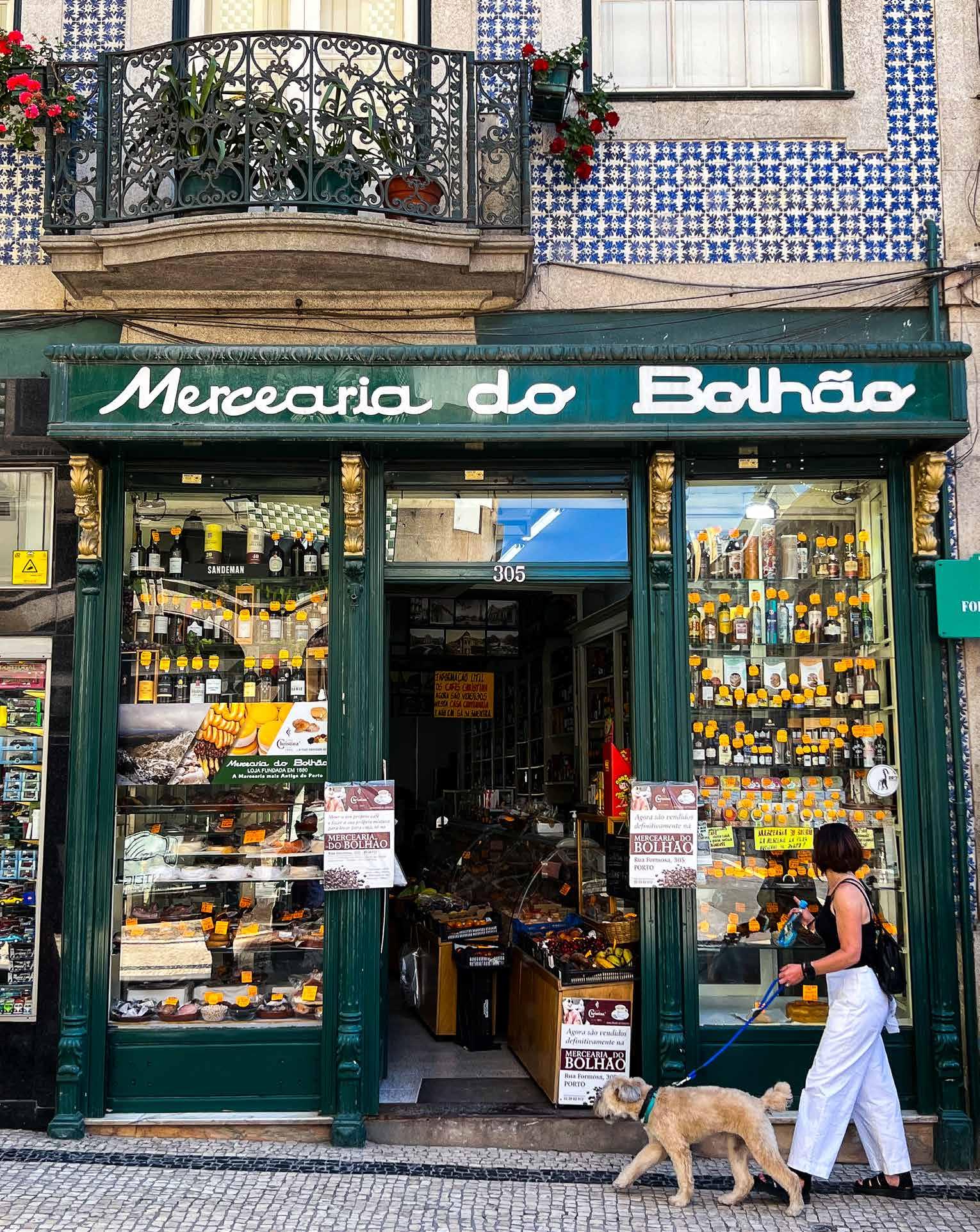

Self described as a coffee garden, this enticing café offers an assortment of healthy, vegan, gluten-free and no-sugar menu items, as well as good coffee and organic teas. The nature-infused interior, hung with plants, exhibits temporary works of local art.



Noshi rents 2 apartments in the restored building, just above the café.
Café: Rua do Carmo, 11/12
Website: noshi.pt
Apartments:
Website: studios.noshi.pt




In operation since 1914, this food market has been “temporarily” located in this structure for the past 4 years. It is the best place in town to buy fresh produce, sliced hams and fresh seafood. There is a bakery with a very interesting bread for sale (shaped like a part of the male anatomy) and a vintner who sells a wide variety of beloved Portuguese wines (and they are very happy to help you make a pairing selection with the fantastic tinned sardines they sell).
This traditional pastry shop has a delectable selection of traditional Portuguese pastries, which were some of the best pastries we sampled in Portugal. Lemoninfused confections that resemble small doughnuts, chocolate balls that melt in your mouth, and more. We adored this part of town, away from the tourists. Just go, eat pastries and explore!
 Rua Martires Liberdade, 34
Rue Fernandes Tomás, 506-508 Website: mercadobolhao.pt
Rua Martires Liberdade, 34
Rue Fernandes Tomás, 506-508 Website: mercadobolhao.pt
This tapas restaurant is known for their yummy pork sandwiches. Order at the counter and, if you happen to order a water here, rather than wine, they will ring a bell and the wine-loving patrons will boo you! Been there, been booed at.
Rua da Picaria, 26


Run by a husband and wife team (he is Portuguese and she is Japanese), this little café at the back of a vintage shop makes plant-based, gluten-free Japanese cuisine in their tiny kitchen. There is a small open air seating area, as well as a table indoors. They sell lovely handcrafted, upcycled light fixtures, ceramics and more. A very charming place for lunch!
Travessa Cedofeita, 28

This little institution is a jam-packed snack bar, and worth a bit of a wait to get a seat at the bar. Known for cacchorinos (similar to a Portuguese version of a hot dog), this Porto specialty is filled with sausage and melted with cheese and spicy sauce in buttered bread over the grill, then sliced. Each bite is mouthwateringly tasty! Open from lunch until late at night.

Two locations:
Travessa Cimo de Villa, 4 Rua de Entreparedes, 8-10 Website: cervejariagazela.pt
This quaint atelier, specializing in pastéis de nata, has locations in both Porto and Lisbon. It buzzes with customers coming in for tarts fresh from the oven, paired with coffee. These tarts are luscious, sprinkled generously with cinnamon.

Rua Mouzinho da Silveira, 27 Website: castropasteisdenata.pt


When I asked our food tour guide, “Where would you recommend we go for dinner on our last night in Porto?” he didn’t hesitate to recommend this little jewel, which is tucked into a quiet, narrow lane. Restaurante Flor dos Congregados is the oldest restaurant in Porto, dating from 1852. It has been run by the Dourado family for the past 80 years. We showed up before it was opened and I asked if we could possibly get a table, explaining that our guide with Taste of Porto had recommended it, and adding, “Do you know Miguel?” for good measure. Yes, he knew Miguel, but they were simply very full, and it was impossible. But, being a squeaky wheel, I pleaded, “But we’re leaving tomorrow, it’s our last night, and I have a magazine!” I had worn him down and he reluctantly replied that we could return at 9:30 pm. Upon our return, he explained that they embrace the idea of slow food and, thus, offer just one seating per evening. The restaurant is small, with just a sprinkling of tables. They want guests to take their time and enjoy every morsel and sip, without feeling the need to rush. The food is delicious and thoughtfully prepared (including the renowned Terylene sandwich, stacked with roasted pork loin and smoked ham, which takes over 24 hours to create!) and they take pleasure in recommending wines to accompany each dish. The maître d’ emphasized the slow concept the restaurant embraces. Don’t leave without ordering the roasted pear in port wine sauce. It is absolutely divine. There is a piano in the corner and, when we were savoring our dessert, the last remaining couple in the restaurant, who happened to be musicians on tour, ambled over to sing and play a couple of tunes, giving us a lovely little performance. It was a memorable way to spend our final evening in this dreamy city.
11 Travessa dos Congregados Website: flordoscongregados.pt Reservations essential

We loved setting up home in an airbnb, smack dab in the historic center of Porto, where we could walk everywhere and hang our laundry on the line at the balcony, as the Portuguese do.
One of the most prestigious porcelain brands in the world, Vista Alegre Porcelain Factory was established by José Ferreira Pinto Basto in 1824, in Ílvao, near the coast, south of Porto (where there is a Vista Alegre Museum. He sought permission from King João VI, who gave his blessing and granted the company the title “Vista Alegre Royal Factory.” It remains the oldest such porcelain producer in Portugal. With a long list of prestigious local and international designers, the wide selection of designs, ranging from classical to contemporary, has large appeal. There is a shop in Lisbon as well as in various towns throughout Portugal.
Rua das Carmelitas, 40050 Website: vistaalegre.com



Known to be one of the world’s most beautiful bookshops, with its iconic wood stairway, finely carved wood paneling and shelving, and striking ceiling of stained glass, Livrario Lello has been in business since 1906. It is worth a peak to see the handsome combination of art nouveau, art deco and neo gothic, and to peruse the books for sale, including some first editions. Snag tickets in advance online, or you will most likely be standing in a long line while ticket holders breeze through the doors.
Purchase tickets for entry online here
Rua das Carmelitas, 144 Website: livrarialello.pt
Image courtesy of Vista AlegraThis boutique curates a fabulous and artful collection of clothing, shoes, jewelry, home decor and more. Every item seems special and is one-of-a kind, created in Portugal by local designers and artists.

Website: panamar.pt
Rua Mouzinho da Silveira, 14
What an aesthetic and lovely shop, inspired by sustainable, fair-trade, handmade local products. There is also an assortment of vintage goods. At the back of the shop is the charming Musumu Café, run by a Portuguese/Japanese couple, serving up Japanese slow food. They also have handcrafted light fixtures, ceramics and more on offer. A unique stop for sure!
Travessa de Cedofeita is a character-filled street that houses several traditional shops and a history going back many centuries.
Website: coracaoalecrim.com
Travessa Cedofeita, 28

You will feel as though you have stepped in time when you visit this delightful shop. Rifle through old stamps and coin collections, old prints, vintage postcards and matchboxes, toys and more curiosities.


Website: collectus.pt
Travessa de Cedofeita, 8D

Tucked in the hinterland just a few kilometers from the coast, sits a wondrous place where nature is deeply revered, and where fortunate guests can sip from nature’s delights. TEIMA is a small boutique hotel that is the epitome of Portuguese country chic.
Website: teima.pt

The Alentejo region stretches west along the Atlantic coast, between Lisbon as it is known, is the westernmost coastline of continental Europe. Along a smattering of small family-run restaurants and groves of fragrant pine dunes and cliffs sprouting wildflowers. Surfers are drawn to the big waves section of Portugal seems to stand still in time, untouched

Lisbon in the north to the Algarve in the south. The Costa Vicentina, Along this wild coastline, you will find acres of farmland and vineyards, pine and eucalyptus. The wide, uncrowded beaches are surrounded by waves along this sleepy coastline. Off the main tourist trail, this stunning by the big development of much of Europe’s coastlines.

Luísa Botelho was looking to buy a property in the area in 2009. Her husband found 6 properties for her to visit. As soon as she stepped onto the land at the 2nd property, it was love at first sight for Botelho and she knew this was the one; she had no interest in seeing anything else. “The atmosphere, the light, the smells… these elements made me fall in love with it,” she recalls. The property included the ruins of a farm, which had sat abandoned in disrepair for many years. The couple made the purchase and built a home of their own. Her husband named it TEIMA which, in Portuguese, translates to the idea of stubbornness (a nod to Botelho’s firmness in deciding it was this plot of land or none at all).

Five years later, Botelho took the plunge and left her job in Lisbon with the intention of transforming their property into a small boutique hotel. So that is what she and her now ex-husband did (they remain partners in the business). They converted their home into 5 rooms and built 4 more. Botelho described the process of transforming the property into what is now the most peaceful, relaxing place for guests to come and unwind in this way: “We went with the flow. We followed the instincts of Mother Nature… My relationship with TEIMA is unequal. I believe there is a feminine will so strong in “her” that she commands me and I do what “she” wants me to do.”


 Images courtesy of TEIMA
Images courtesy of TEIMA
The idea of stubbornness is emphasized by the brand’s logo… a donkey. And, no surprise, donkeys are in residence on the property, living their best life. I asked Botelho about the donkeys. “The first donkey we acquired was Rosa, a middle aged character and sweet animal that we bought from a gypsy, who made her work hard and have many foals. We decided to allow her the best retire ment possible, and she has always paid us back by being so lovely. Rosa became our mascot and the face of the farm.”
Along with the donkeys, a menagerie of horses, ducks, a dog and a cat reside in peaceful, contented existence. A house for the ducks floats in the center of the pond. Bird song wafts along to the whisper of the tall grove of pine trees moving in the breeze. Frogs and turtles live among the lily pads in the garden. The harmony of nature is pal pable here.
Rooms are decorated with natural textures, a fusion of organic and modern style, each space with its own color theme. All rooms have private terraces with views of the countryside and swimming pool, as well as comfortable seating areas for relaxation.

The staff makes a concerted effort to make sure guests feel at home by providing the best service possible. Mas sages can be arranged in a lovely open-air pavilion. Breakfast is a delicious, thoughtfully arranged spread. Every detail is lovely and resonates with a sense of calm
The intention is for guests to be embraced by the quiet ness, the unique atmosphere, the close contact with na ture and animals and the pure beauty of it. We certainly felt that way during our visit. Time simply melted away and we felt caressed by the soothing spirit of the land, the peaceful energy of the happy animals and the con tented feeling of being infused with nature’s harmony. We were loath to peel ourselves from TEIMA when the time came for us to leave, but grateful for the opportu nity we had to experience this unique and special place, nestled in the hills of the southwest Alentejo.

 Image courtesy of Burel Wool Factory
Image courtesy of Burel Wool Factory


With a passion for recovering world heritage, Portuguese stories and culture, husband and wife, Isabel Costa and João Tomás, came across a derelict factory, Lanífícios Império, while exploring the Serra de Estrela mountains. What had been a former weaving factory, established in 1942 to create the burel (traditional wool fabric) to weave traditional clothing for the shepherds in the surrounding mountains, as well as habits for the local religious order, was found in absolute ruins. Costa and Tomás saw this as an opportunity to create something new from this historical component of Portuguese heritage. At the time, more than 50% of the population was unemployed.


They wanted to recover traditional mountain products, while creating new jobs. They set to work, rebuilding the factory and restoring the machinery (which dated from the 18th and 19th centuries), launching their new company, Burel Factory, in 2010, and saving this industrial heritage. Fast forward to today and Burel is the largest employer in Manteigas. The company operates three main facets of the business. Each department has its own creative director, with its own team and shop based in Lisbon (there is also a shop in Porto).


 Image courtesy of Burel Wool Factory
Image courtesy of Burel Wool Factory
Image courtesy of Burel Wool Factory
Image courtesy of Burel Wool Factory
Costa has a background in management, and worked in a retail company as a board member for 20 years, so she knows a thing or two about leading a company.

I visited with Isabel Costa during a visit to the Burel Factory in Manteigas, while staying at the lovely wonderful Casa de São Lourenço. Along with answering my many questions, she walked me through the factory, explaining the process of weaving burel, from raw wool to finished fabric. Read the interview below.

 Images courtesy of Burel Wool Factory
Images courtesy of Burel Wool Factory
Burel Architecture – This department produces a variety of beautiful and ingenious acoustic solutions, including screens, panels and the simple curtain which, I was told, absorbs 95-100% of noise. They play with modern-day versions of tangrams (the old Chinese puzzles), using simple geometric shapes to form a variety of fun and functional panels on walls. The possibilities are endless.
Burel woven densities commercial fashion

Burel Fabrics – The burel wool fabric is woven on antique looms in 4 different densities for use in residential and commercial applications, as well as for the fashion industry.

3D Stitches – With 20 stitch designs in burel wool in a spectrum of more than 80 colors, the 3-dimensional fabric is finished by hand and is customized for use as wallcovering, as well as used as cushion covers, rugs, furniture and home décor.


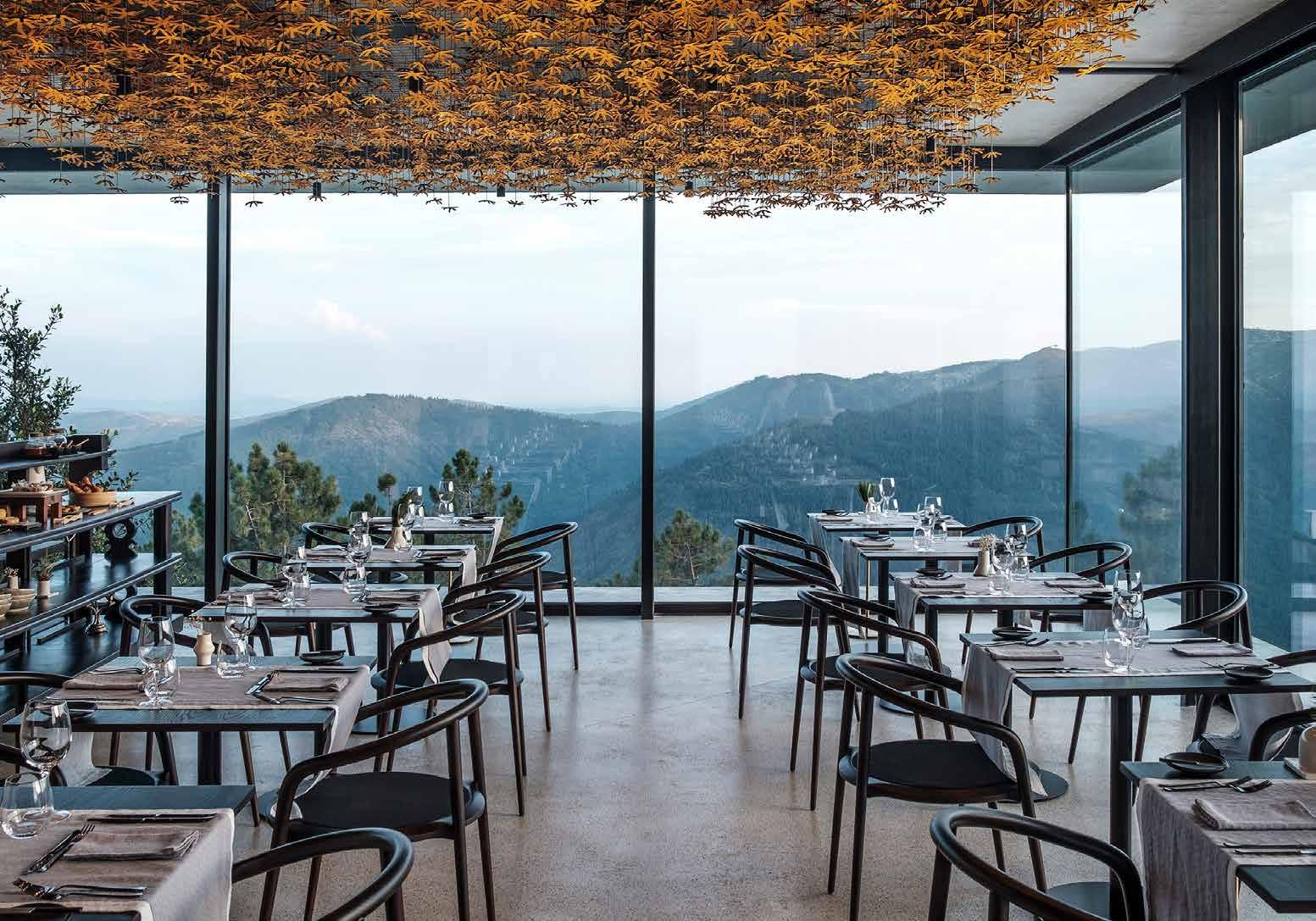



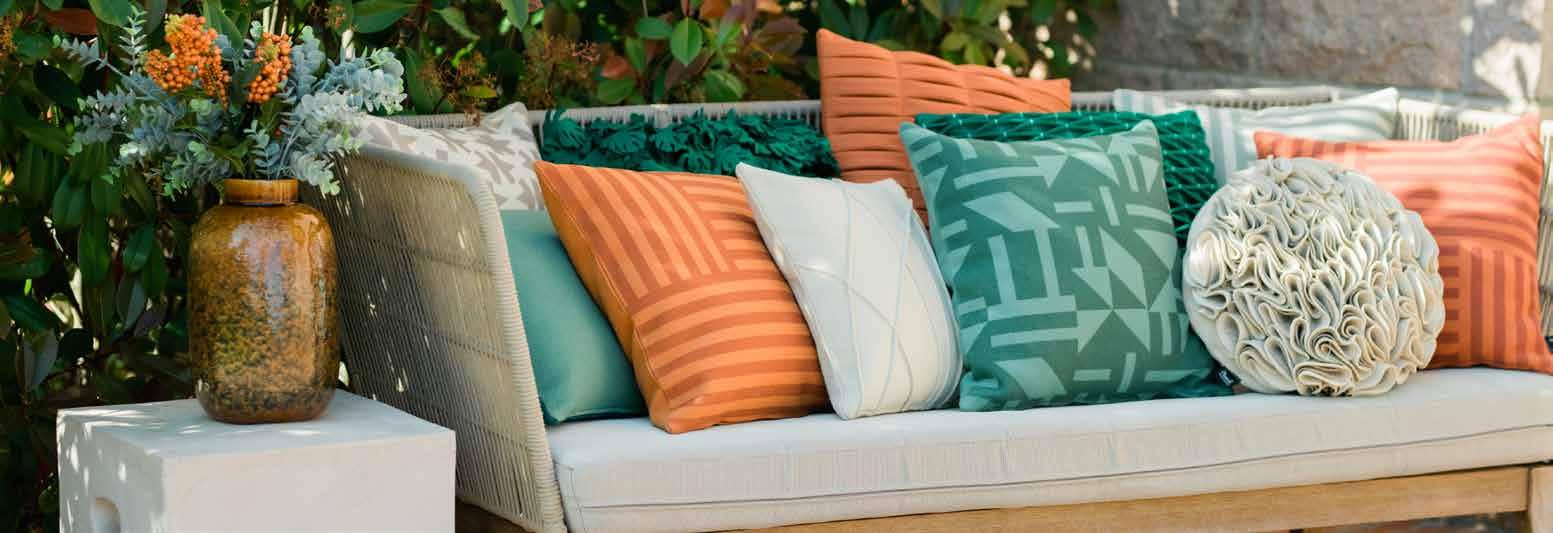 Image courtesy of Burel Wool Factory
Image courtesy of Burel Wool Factory
Image courtesy of Burel Wool Factory
Image courtesy of Burel Wool Factory
Image courtesy of Burel Wool Factory
Image courtesy of Burel Wool Factory
Image courtesy of Burel Wool Factory
Image courtesy of Burel Wool Factory
Burel also runs two boutique hotels in the mountains above Manteigas, at an altitude of 1500 meters and 1250 meters, respectively. They are surrounded by hiking trails, beautiful mountain views and generously infused with a sense of peace, quiet and, of course, an abundance of burel wool.
Burel Expecdition Hotel
Opened in 2006 in a converted sanatorium at the top of the mountain. The design is reminiscent of a mid-century ski chalet. It is abundant in warm wood, punctuated by the bold hues of many Burel pieces, including blankets, pillows, rugs, draperies and furnishings.
Burel Panorama Hotel
This design hotel was opened in 2018, converted and restored from a pousada (historic building). It exudes calm and understated luxury, with a simple Scandinavian vibe, in a subdued color palette. Walls, ceilings and headboards are upholstered in burel. Room numbers are stitched directly onto the wool walls. In the dining room, there are thousands of small stars cut from wool, suspended from the ceiling (there is a story in these mountains about the estrela, or star, signifying Christ’s birth). What a brilliantly effective and beautiful acoustic solution!
Casa de São Lourenço
Website: casadesaolourenco.pt
Casa das Penhas Douradas
Website: casadaspenhasdouradas.pt
I love the brand. I love how you have taken something that is an old art form, a part of Portugal’s history, and you have brought it into the present and made it modern.
Yes, we try to do that. We maintain some historic patterns from the region, but we are always creating new ones as well.
It is really interesting that some of the historic patterns look so contemporary and retain a relevance to modern day design.
Yes, in Portugal we have quite a bit of these kinds of examples in both patterns and handicrafts. We incorporate influences from the past but we are completely contemporary.


What inspires your work and your design, other than trends?
We are inspired by the natural environment and by the past. It encapsulates the brand… handmade, steeped in nature and the mountains. We always try to maintain a concept that is simple and natural.
When you began building your company in 2010, how long did it take for you to be up and running, producing the burel?
We are inspired by the natural environment and by the past. It encapsulates the brand… handmade, steeped in nature and the mountains. We always try to maintain a concept that is simple and natural.
When you began building your company in 2010, how long did it take for you to be up and running, producing the burel?
We had shops opened within 18 months. It took us 8 to 9 months to rebuild the physical structure, since it was completely destroyed, and to install all the machines and get them working again.
So, you were to find people who knew how to operate the antique machines?
Yes, the most important thing was that we had access to people who were alive, who were able to teach us how to operate the machines. You can have machines but, without the knowledge, which is most important, it would be impossible to start this company.
We use both. The former factory only created burel in the natural colors of the sheep wool. We introduced color when we started our company and typically use synthetic dyes from Germany and Switzerland that have environmental certification. In the future we intend to use more and more natural dyes, from plants and flowers.
Yes, we recycle 100%. We save all waste, then we destroy the waste material and begin creating the fiber again. This results in burel that has a heathered look.
What’s your primary role? Do you and your husband have different roles?
I work in the industry and João works more in hotels. We also have one other recently acquired factory one hour away.

For Architecture products our largest clients are the Nordic countries. For fashion and garments, our main clients are in UK. And for home decoration, European countries are the primary clients, particularly Germany, France, Switzerland and Scandinavia. For online shopping our biggest client is the USA.
 Images courtesy of Burel Wool Factory
Images courtesy of Burel Wool Factory
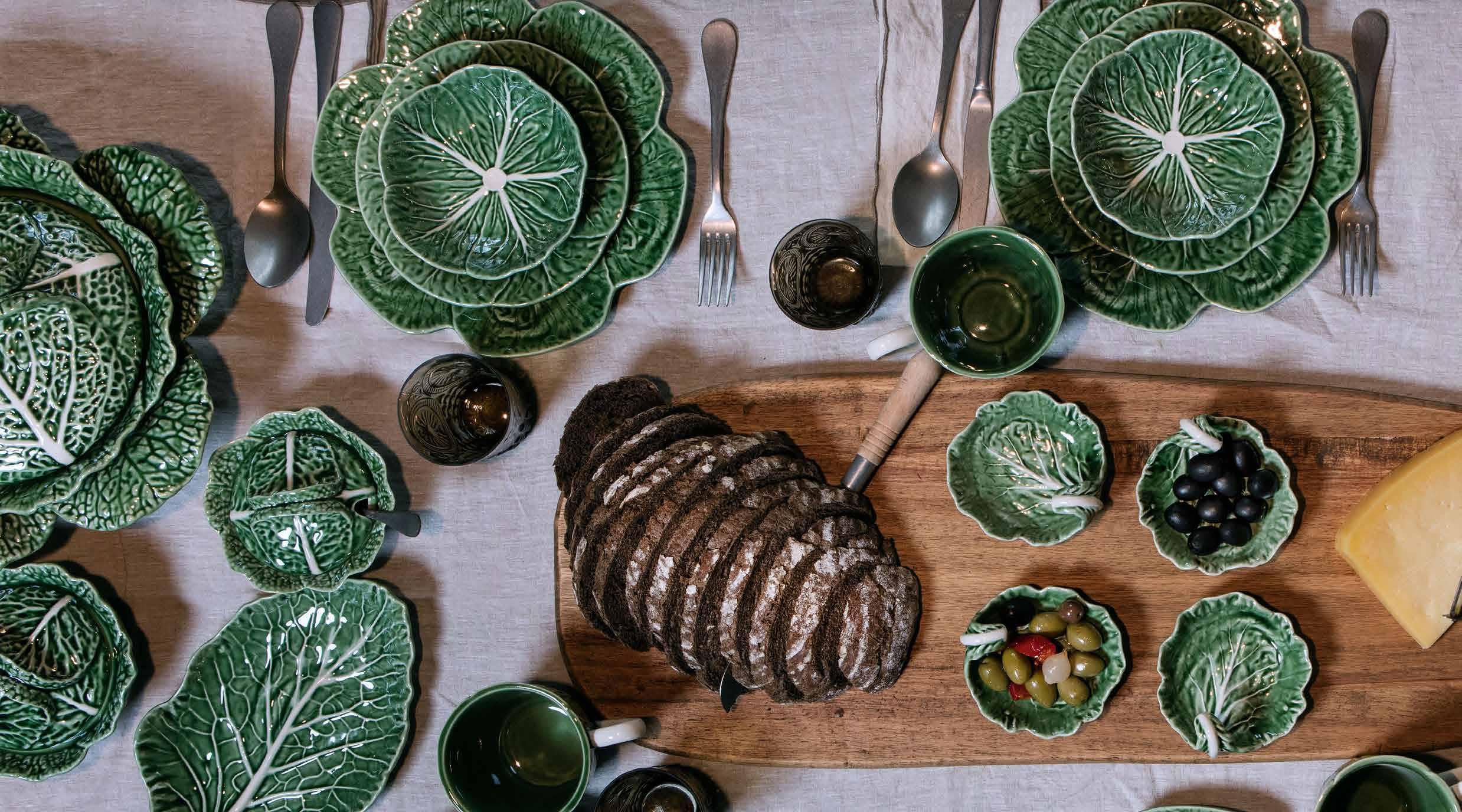
Raphael Bordallo Pinheiro (1846-1905) was one of Portugal’s most iconic and beloved artists. Known drawings, as well as his ceramic creations, he was one of the most influential people of 19th century
In 1884 Bordallo Pinheiro began producing ceramics at the Fábrica de Faianças in Caldas, where ramic art until his death in 1905. The breadth of his ceramic work included tiles, panels, pots, centerpieces, animals and more. After his death, his son, Manuel Gustavo Bordallo Pinheiro continued his father’s When he passed away, a group of influential people continued the Bordallo Pinheiro tradition the company was purchased by Grupo Visabeira. The company ensures the preservation of the takes place in the factory where he created his ceramics, known today as Faianças Artísticas Bordallo
Bordallo Pinheiro’s ceramic creations, many of which are rooted in flora and fauna, remain wildly popular today and can be found in shops throughout the country. Dinnerware, serving pieces and more are painted in exuberant hues. They delightfully illustrate, in clay, the unfurled leaves of cabbage, juicy ripe strawberries, delicate melons and so on. They punctuate dinner tables in Portugal and abroad, and are a delight to behold and to eat from. We couldn’t help ourselves from ducking into every shop we passed with a Bordallo Pinheiro ceramics display in the window, and admiring all the wonderful pieces. If you can load some into your carry on luggage, by all means DO, because prices are about a third of what you will pay in the US.
Known for his caricature art and humorist century Portuguese culture.
where he continued creating a vast range of cecenterpieces, fountain basins, dishes, vases, father’s work to keep the ceramic tradition alive. at Caldas. After the financial crisis in 2008 the artist’s legacy and production, which still Bordallo Pinheiro Ltd.
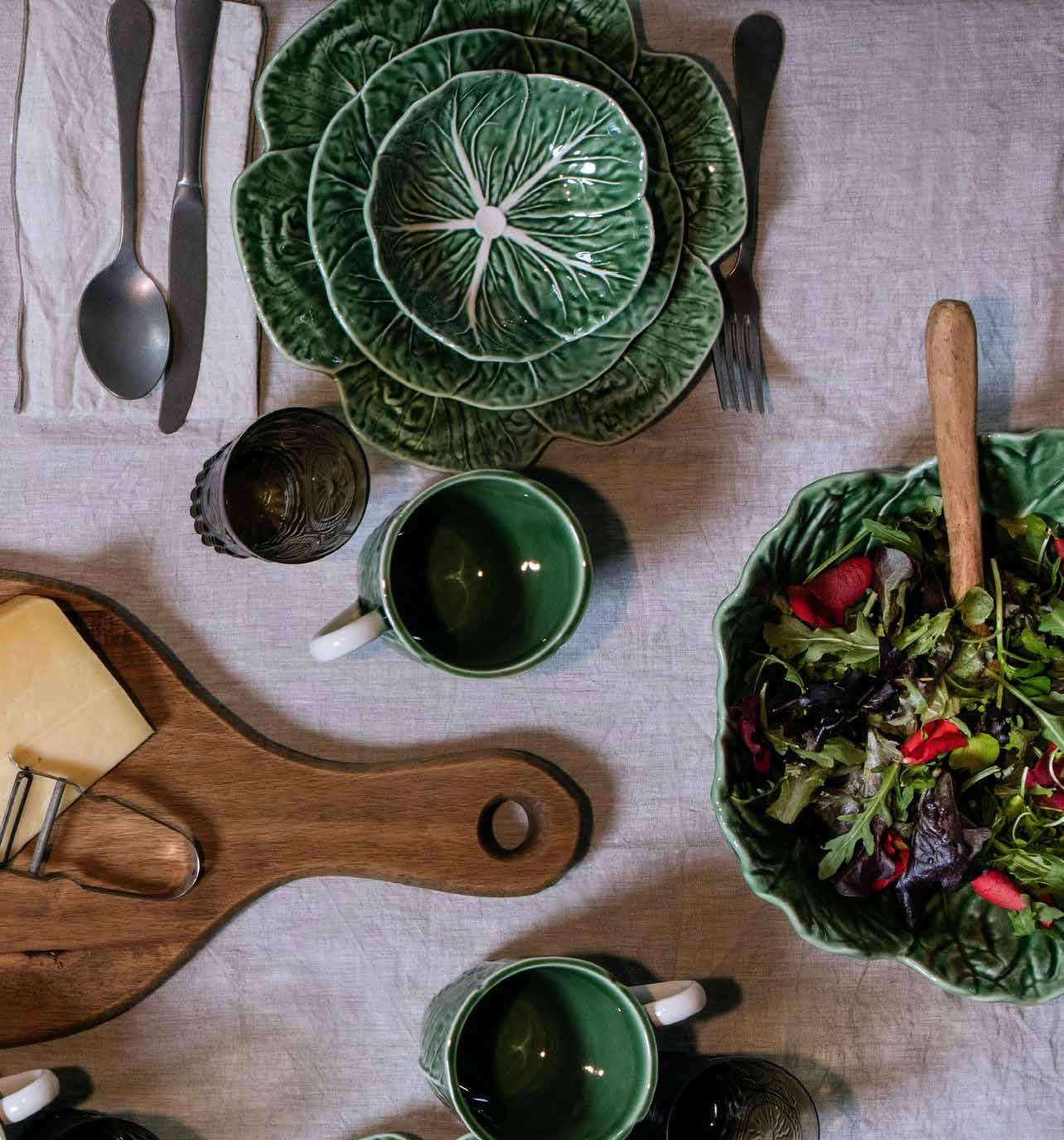
The Vista Alegre Porcelain Factory was founded in 1842.

You can purchase in the US online at Bordallo Pinheiro

Xico
Luisa Sobras
Recantiga
Miguel Araújo
Pica do 7
António Zambujo
Amor Ladrão
Cuca Roseta
Será Amor
César Mourão
Chuva No Mar
Carminho (feat. Marisa Monte)
Inês
Luisa Sobras
Fado Portugese
Amália Rodrigues
Amar Pelos Dois
Salvador Sobral
Corzinha De Verão
Camane
Se De Um Rio
Gisela Joao
A Pele Que Há Em Mim
Marcia, JP Simões
The sounds of vintage Portugal... The impassioned songs of fado’s mournful expressions of saudade, including Portugal’s beloved queen of fado, Amália Rodriguez. The soulful voice of 2017 Eurovision winner, Salvador Sobral, and the intimate croon of his sister, Luísa. These music selections are reminiscent of being in a small vintage Portuguese dinner club, where the port and the music flow.
Listen To the whole playlist on Spotify


Companhia Portugueza do Chá
(Portuguese Tea Company)
The shop in Lisbon is housed in a picturesque old shoe store dating from 1880.
Their delicious teas and blends are sold in fine hotels, cafés and restaurants in Lisbon.
Upon asking for a recommendation, the shopkeeper suggested the Ginger, Apple & Rose Bio blend, adding, “It tastes like springtime.”
Rue do Poço dos Negros, 105 Website: companhiaportuguezadocha. com


Pastel de nata, or pastéis de nata, if you’re referring to the plural (which is likely, since it’s impossible to eat just one) is one of the many culinary delights of Portugal. The meltin-your-mouth Portuguese egg tart consists of a layered, buttery crust, which cradles a luscious egg custard center. When you take a bite, the crisp, flaky crust shatters into a hundred tiny pieces. They can be found at the many pastelarias (pastry shops) throughout Portugal.
The pastel de nata originated in the Jerónimos Monastery in the Santa Maria parish in Belém, Lisbon, sometime during the 18th century. At the time, convents and monasteries used countless egg whites for starching clothing. With all the leftover egg yolks they concocted cakes and pastries. Following the revolution of 1820, religious orders were dissolved and many convents and monasteries faced closure. The monks from the Jerónimos Monastery began selling pastéis de nata at a local sugar refinery to earn some income. The monastery closed in 1834 and the recipe was sold to the refinery, where it remained a secret.
There are many versions of recipes for pastéis de nata circulating today. I adapted this recipe after testing some I found online and I’m happy with these little golden treasures.

Pastry dough:
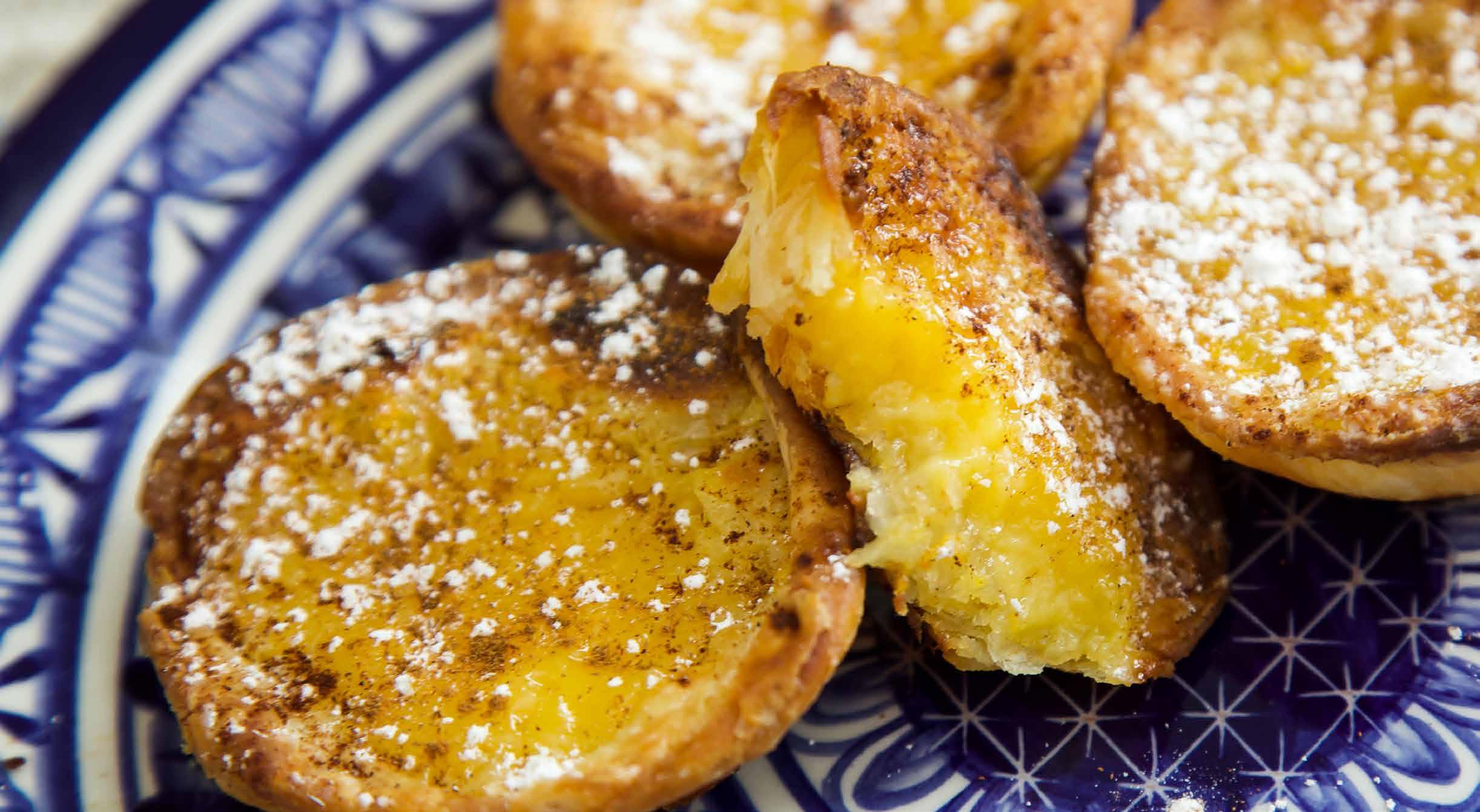
2 cups all-purpose flour
¼ teaspoon sea salt
¾ cup ice cold water
1 cup unsalted butter, softened and stirred until smooth
Custard:
3 tablespoons all-purpose flour
1 1/4 cups milk, divided
1 1/3 cups granulated sugar
1 cinnamon stick
2/3 cup water
1 teaspoon vanilla extract
6 large egg yolks, whisked
1. Using a stand or hand held mixer, mix the flour, salt and water for approximately 30 seconds, until a dough forms and pulls away from the side of the bowl.
2. Flour a work surface and pat the dough into a 6” square. Lightly flour the dough, cover with plastic wrap and let rest for 15 minutes.
3. Roll the dough into an 18” square. Use a pastry scraper to lift the dough as you work, to ensure it is not sticking to your work surface.
4. Using a rubber spatula, spread the left 2/3 surface of the dough with about 1/3 of the butter, making sure to leave a 1” unbuttered border around the edge of the dough.
5. Fold the unbuttered side of the dough over the middle third, then fold the left third over, as you would fold a letter. Gently pat down the dough to release any air bubbles, and straighten the edges..
6. Lift dough and flour work surface. Rotate dough so the shorter side is facing you. Roll out dough to an 18” square. Again, spread 1/3 of the butter onto the left 2/3 of dough. Fold the dough as previously done in steps 4 and 5.
7. Rotate the dough 90° to the left and, this time, roll the dough to an 18” x 21” rectangle, with the shorter edge facing you. Spread the remaining butter across the entire surface of the dough, leaving a 1” unbuttered border at the top edge furthest from you..
8. Lift the short edge of the dough nearest to you and roll it into a tight log, brushing the excess flour from the underside as you roll. Trim the ends and cut the log in half. Wrap each piece in plastic wrap and chill for 2 hours or overnight.
Note: If you want to make fewer tarts, freeze one log in a freezer bag (for up to 3 months) and halve the recipe for the custard.

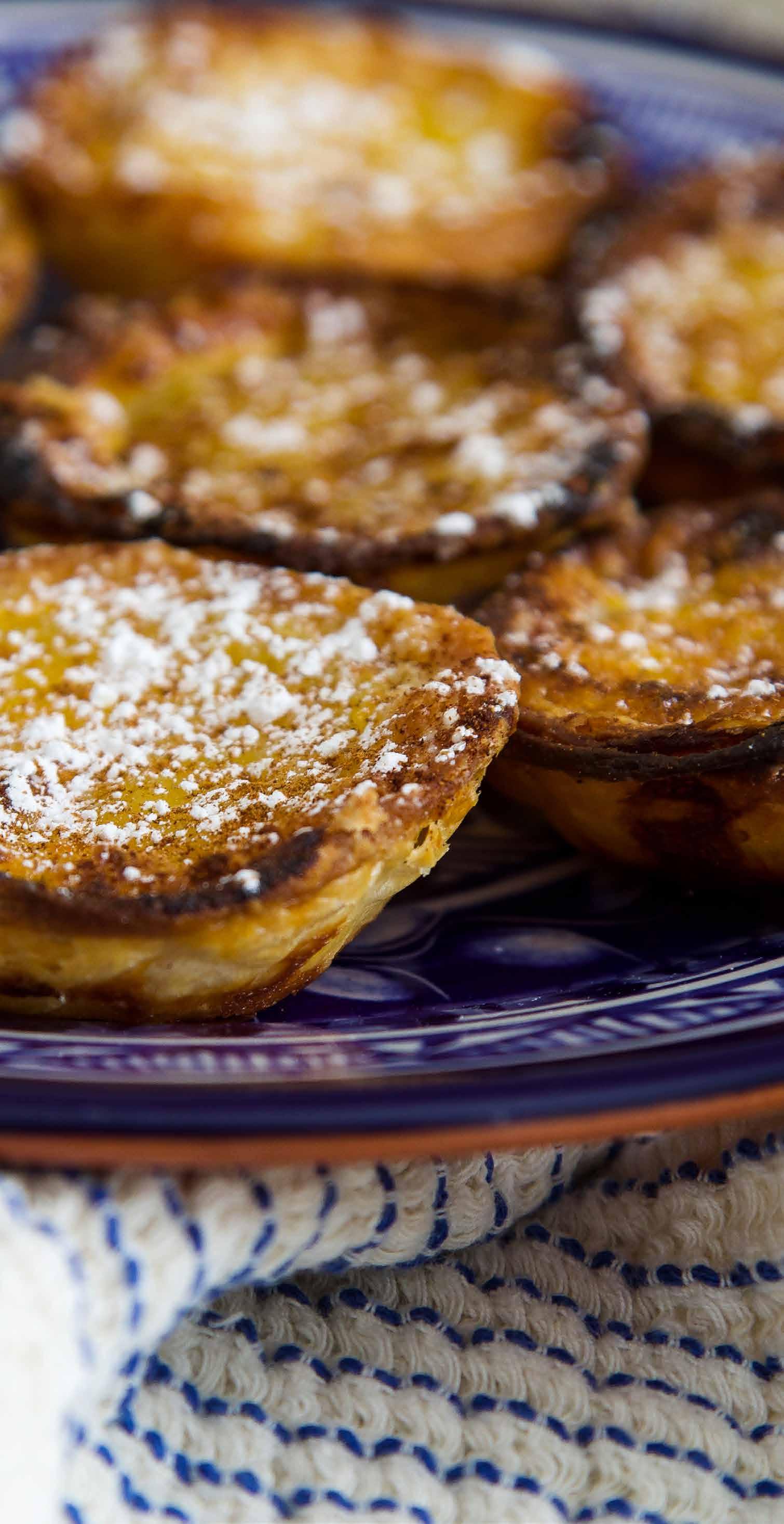
1. Whisk flour and ¼ cup milk in a medium bowl until smooth.
2. In a small saucepan, bring sugar, cinnamon stick and water to a boil on medium heat, cooking (without stirring) until a candy thermometer reaches 215°.
3. Place the remaining 1 cup milk in a different small saucepan and heat to scalding. Then whisk the hot milk into the flour mixture.
4. Discard cinnamon stick and slowly pour the sugar syrup into the hot milk and flour mixture, whisking continuously until well combined. Add the vanilla and whisk until well combined. Let cool for 8 to 10 minutes until warm. Whisk in the yolks, strain into a large glass measuring cup, cover with plastic wrap and set aside. The custard will be runny.
1. Heat oven to 550° (make sure oven rack is in the top third position)
2. Roll a chilled pastry log with your hands, on a lightly floured surface, until it is 1” in diameter and approximately 16” long. Score log into 18 pieces, using a knife; cut through. Repeat with the second log. Place each piece, cut side down, into each well of a small Portugese tart pan (I purchased mine here) Alternatively, you can use non-stick muffin tins (and if you do this, cut each dough log into 12 pieces, as muffin pans are deeper than the individual tart pans).
3. With a small bowl of water in front of you, dip your thumb in water. Press your thumb into the center of the swirl; push dough against the base and up the sides, creating a raised lip approximately 1/8” above the top edge of the tart pans.
4. Place individual tart pans onto a cookie sheet and fill each pan with custard to approximately ¼” below the rim of the pastry (or ¾ full if using muffin cups). Bake until the pastries are lightly browned and the tops of custard are bubbly and caramelized, approximately 12 minutes.

5. Remove from the oven and immediately slide the tarts (in their pans) onto a cooling rack. Cool for a few minutes, then remove each tart from its pan. Before serving, sprinkle the tarts with powdered sugar and cinnamon. The pastéis de nata are best eaten warm (but make sure to consume within two days).
Recipe makes 3 dozen tarts, if using individual tart plans, or 2 dozen, if using muffin tins.
theloadedtrunk.com
 Concept by Jonna Robison
Concept by Jonna Robison
jonnarobison.com
Produced and designed by Sophie Robison

All photographs (except where noted)
by Jonna Robison